Physical Address
304 North Cardinal St.
Dorchester Center, MA 02124
The gastrointestinal (GI) tract is a hollow tube extending from the oral cavity to the anus that consists of anatomically distinct segments including the esophagus, stomach, small intestine, colon, rectum, and anus. Each of these segments has unique, complementary, and highly integrated functions, which together serve to regulate the intake, processing, and absorption of ingested nutrients and the disposal of waste products. The regional variations in structure and function are reflected in diseases of the GI tract, which often affect one or another segment preferentially. Accordingly, following consideration of several important congenital abnormalities, the discussion is organized anatomically. Disorders affecting more than one segment of the GI tract, such as Crohn disease, are discussed with the region that is involved most frequently.
Depending on both the nature and the timing of the insult during gestation, a variety of developmental anomalies can affect the GI tract. Importantly, because many organs develop simultaneously during embryogenesis and are susceptible to the same insults, the presence of congenital GI anomalies should prompt evaluation of other organs.
Atresia, fistulae, and duplications may occur in any part of the GI tract. When present within the esophagus they are discovered shortly after birth, usually due to regurgitation during feeding. Most of the lesions are incompatible with survival without prompt surgical repair. Absence, or agenesis, of the esophagus is extremely rare, but atresia, in which development is incomplete, is present in 1 to 5 infants per 10,000 live births. In atresia, a segment of the esophagus does not develop, leaving only a thin, noncanalized cord and causing a mechanical obstruction ( Fig. 17.1A ). Atresia occurs most commonly at or near the tracheal bifurcation and is usually associated with a fistula connecting the upper or lower esophageal segments to a bronchus or the trachea ( Fig. 17.1B ). In other cases a fistula can be present without atresia ( Fig. 17.1C ). Any of the three primary forms of tracheoesophageal fistula can lead to aspiration, suffocation, pneumonia, and severe fluid and electrolyte imbalances. Developmental abnormalities of the esophagus are associated with a range of congenital abnormalities, including VACTERL (malformations including vertebral, anal, cardiac, tracheoesophageal, renal, and limb defects); TACRD (tracheal agenesis/atresia, complex congenital cardiac abnormalities, radial ray defects, and duodenal atresia); and other abnormalities involving the heart, lung, great vessels, genitourinary tract, and anus. The last-mentioned includes imperforate anus, which is due to a failure of the cloacal diaphragm to involute.
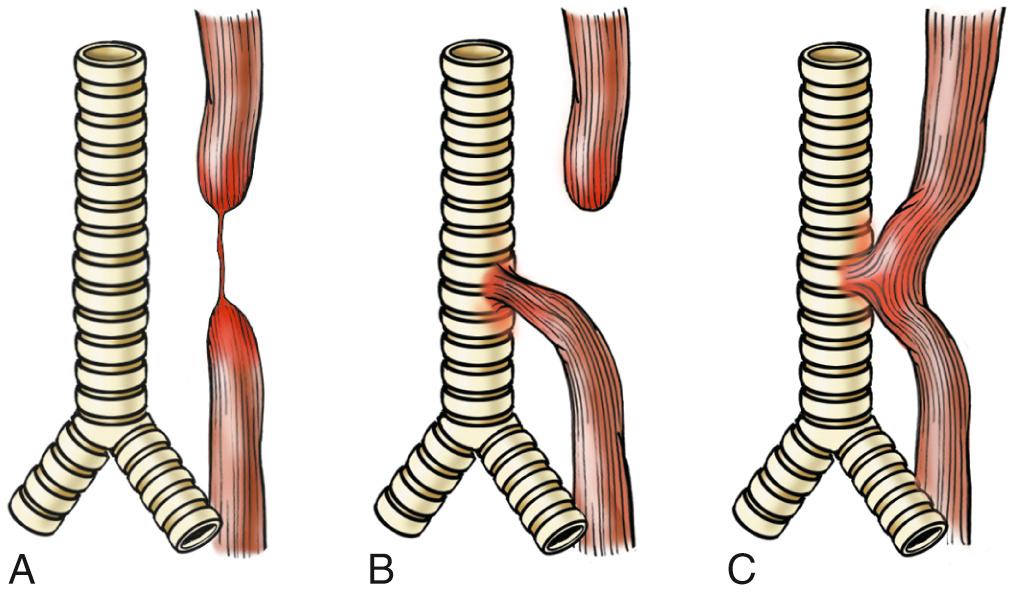
Stenosis is an incomplete form of atresia in which the lumen is markedly reduced in caliber as a result of fibrous thickening of the wall. This results in either partial or complete obstruction. In addition to congenital forms, stenosis can be acquired as a consequence of inflammatory scarring, such as that caused by chronic gastroesophageal reflux, irradiation, systemic sclerosis, or caustic injury. It can involve any part of the GI tract, but because of their smaller caliber, clinically significant stenosis most often affects the esophagus and small intestine.
Diaphragmatic hernia occurs when incomplete formation of the diaphragm allows the abdominal viscera to herniate into the thoracic cavity, most commonly on the left side. When severe, the space-filling effect of displaced viscera can lead to potentially fatal pulmonary hypoplasia.
Omphalocele occurs when the extraembryonic gut fails to return to the abdominal cavity and closure of the abdominal musculature is incomplete. As a result, abdominal viscera (including the liver) herniate ventrally into a membrane covered by amnion and peritoneum separated by Wharton jelly. Omphalocele is often associated with other birth defects as well as chromosomal abnormalities.
Gastroschisis is similar to omphalocele except that it involves all the layers of the abdominal wall, from the peritoneum to the skin, is usually limited to the intestine, and occurs as an isolated defect without other abnormalities. The incidence of gastroschisis is rising, possibly due to environmental factors including smoking and exposure to agricultural chemicals. Surgical repair of omphalocele and gastroschisis is generally successful.
Ectopic tissues (developmental rests) are common in the GI tract. The most frequent site of ectopic gastric mucosa is the upper third of the esophagus, where it is referred to as an inlet patch. While generally asymptomatic, acid released by gastric mucosa within the esophagus can result in dysphagia, esophagitis, Barrett esophagus, or, rarely, adenocarcinoma. Ectopic pancreatic tissue occurs less frequently and is found in the esophagus or stomach. These nodules are most often asymptomatic but may produce local damage and inflammation. When ectopic pancreatic tissue is present in the pylorus, inflammation and scarring may lead to obstruction. Because rests may be present within any layer of the gastric wall, they can mimic invasive cancer. Gastric heterotopia, small patches of ectopic gastric mucosa in the small bowel or colon, may present with occult blood loss due to peptic ulceration of adjacent mucosa.
A true diverticulum is a blind outpouching of the alimentary tract that communicates with the lumen and includes all three layers of the bowel wall. The most common true diverticulum, and the most common congenital anomaly of the GI tract, is Meckel diverticulum, which occurs in the ileum. Meckel diverticulum occurs due to failed involution of the vitelline duct, which connects the lumen of the developing gut to the yolk sac. This solitary diverticulum extends from the antimesenteric side of the bowel ( Fig. 17.2 ). The “rule of 2's” is often used to help remember characteristics of Meckel diverticula, which:
Occur in approximately 2% of the population
Are generally present within 2 feet (60 cm) of the ileocecal valve
Are approximately 2 inches (5 cm) long
Are twice as common in males
Are most often symptomatic by age 2 (only approximately 4% are ever symptomatic).
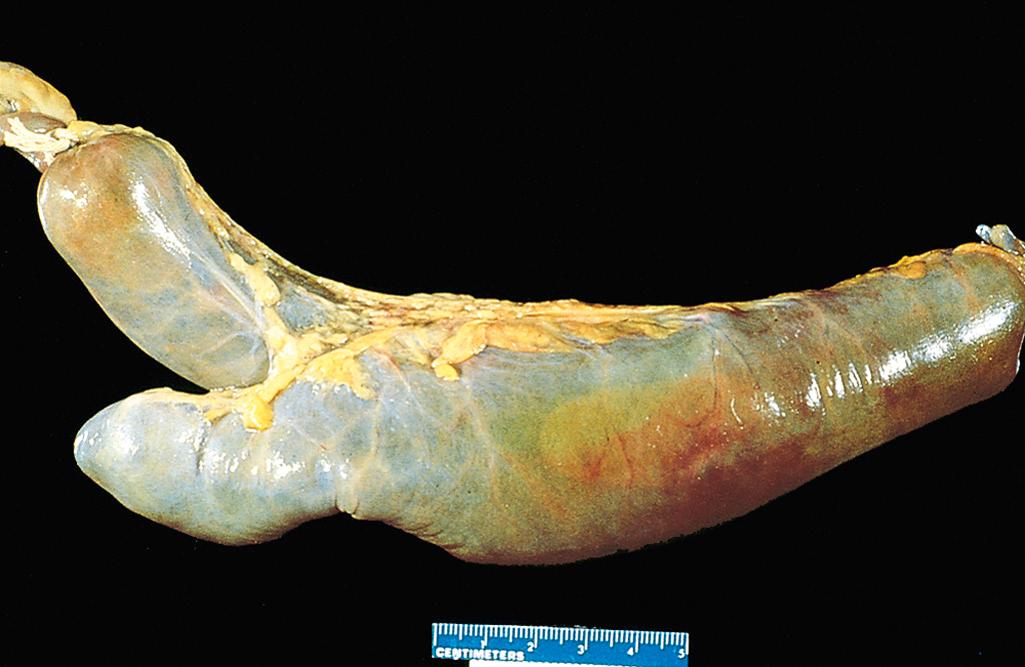
The mucosal lining of Meckel diverticula may resemble that of normal small intestine, but ectopic pancreatic or gastric tissue may also be present. The latter may secrete acid, cause peptic ulceration of adjacent small intestinal mucosa, and present with occult bleeding or abdominal pain resembling acute appendicitis or obstruction.
Virtually all other diverticula are acquired and either lack muscularis entirely or have an attenuated muscularis propria. These are, technically, pseudodiverticula, but are generally referred to simply as divericula. They occur most often in the sigmoid colon (discussed later).
Pyloric stenosis may be either congenital or acquired. The most common congenital form is congenital hypertrophic pyloric stenosis. It is three to five times more common in males and has an overall incidence of 1 per 300 to 900 live births. Monozygotic twins have a high rate of concordance; risk is increased to a lesser degree in dizygotic twins and siblings of affected individuals. Turner syndrome and trisomy 18 also confer an increased risk. While the underlying mechanisms are not understood, erythromycin or azithromycin exposure, either orally or via mother's milk, in the first 2 weeks of life is associated with this disorder.
Congenital hypertrophic pyloric stenosis generally presents between the third and sixth weeks of life as new-onset regurgitation, projectile nonbilious vomiting after feeding, and frequent demands for refeeding. Physical examination reveals a firm, ovoid, 1- to 2-cm abdominal mass in up to 90% of cases; abnormal left-to-right hyperperistalsis just before vomiting is also common. Diagnosis is primarily by ultrasonography. Anatomically, the gastric outflow tract is obstructed by hyperplasia of the pyloric muscularis propria. Edema and inflammatory changes in the mucosa and submucosa may aggravate the narrowing. Surgical splitting of the muscularis (myotomy) is curative.
Acquired pyloric stenosis occurs in adults as a consequence of antral gastritis or peptic ulcers close to the pylorus. Carcinomas of the distal stomach and pancreas may also narrow the pyloric channel due to fibrosis or malignant infiltration.
Hirschsprung disease causes functional obstruction of the colon due to failure of ganglion cells to migrate to the wall of the colon resulting from a mutation in the receptor tyrosine kinase. Hirschsprung disease occurs in approximately 1 in 5000 live births. It may be isolated or occur in combination with other developmental abnormalities; 10% of all cases occur in children with Down syndrome, and serious neurologic abnormalities are present in 5% of infants with Hirschsprung disease.
The enteric neuronal plexus develops from neural crest cells that migrate into the bowel wall during embryogenesis. Hirschsprung disease, also known as congenital aganglionic megacolon, results when the migration of neural crest cells from cecum to rectum is arrested prematurely or when the ganglion cells undergo premature death. This produces a distal intestinal segment that lacks both the Meissner submucosal plexus and the Auerbach myenteric plexus, termed aganglionosis. Coordinated peristaltic contractions are absent, and functional obstruction occurs, resulting in dilation proximal to the affected segment.
Heterozygous loss-of-function mutations in the receptor tyrosine kinase RET account for the majority of familial and approximately 15% of sporadic Hirschsprung disease cases. The association between Down syndrome and Hirschsprung disease may be linked to the Down syndrome cell adhesion molecule gene on chromosome 21, overexpression of which leads to neural defects in experimental models. In patients without trisomy 21, germline mutations in several genes that are required for normal gut innervation have been implicated, the most common of which involve RET and EDNRB or EDN3 (which encode a receptor-ligand pair). These proteins appear to participate in signaling pathways that regulate development of the enteric nervous system. Defects in known genes cannot explain all cases, however, and penetrance in those carrying pathogenic mutations is incomplete, suggesting that modifying genes or environmental factors are also important. Some of these modifying genes may be sex-linked, since the disease is more common in males, but, when present in females, the affected aganglionic segment tends to be longer.
Diagnosis of Hirschsprung disease requires histologic confirmation that ganglion cells are absent within the affected segment. In addition to their characteristic morphology in hematoxylin and eosin–stained sections, ganglion cells can be identified using immunohistochemical stains for acetylcholinesterase.
The rectum is always affected, but the length of the additional involved segments varies widely. In most cases the abnormality extends to the sigmoid colon, but in severe cases, the entire colon may be involved. Disease limited to the rectosigmoid is termed short-segment Hirschsprung disease, while cases with more proximal extension are termed long-segment Hirschsprung disease.
The aganglionic region may have a grossly normal or contracted appearance. In contrast, the normally innervated proximal colon undergoes progressive dilation ( Fig. 17.3 ) and may become massively distended (megacolon) as a result of the distal obstruction. The colonic wall may be stretched to the point of rupture, which occurs most frequently near the cecum. Mucosal inflammation or shallow ulcers may also be present in normally innervated segments, making gross identification of the extent of aganglionosis difficult. Hence, intraoperative histopathologic analysis (frozen section) is commonly used to confirm the presence of ganglion cells at the anastomotic site.
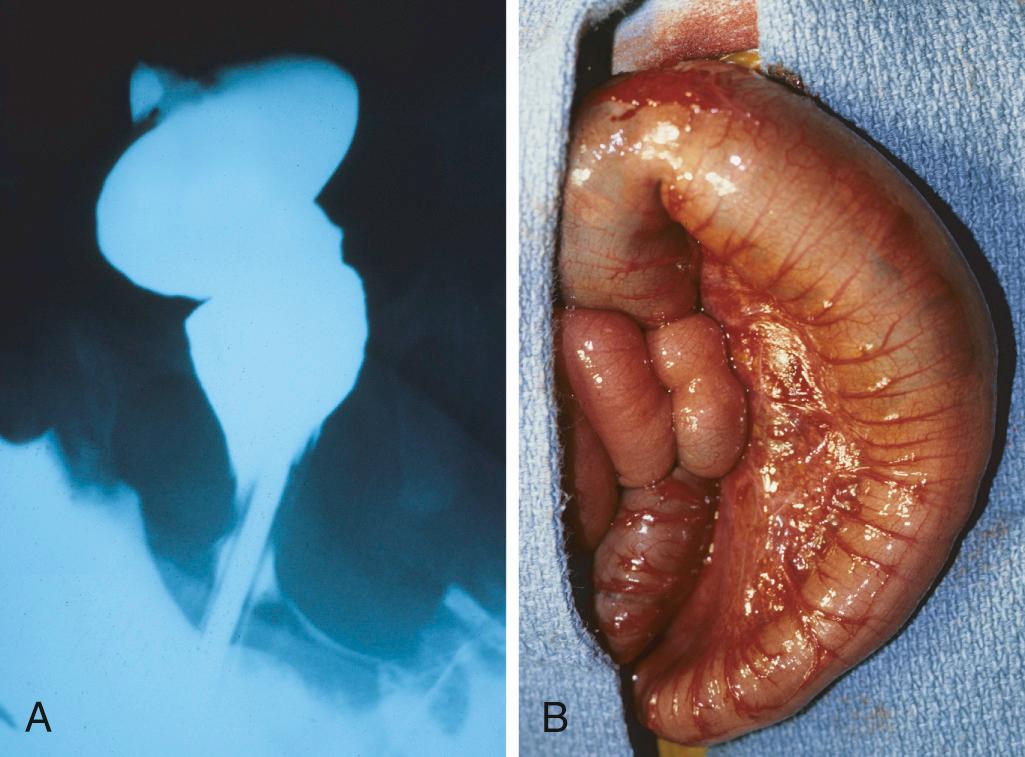
Hirschsprung disease typically presents with a failure to pass meconium in the immediate postnatal period. Obstruction or constipation follows, often with visible but ineffective peristalsis. When only a few centimeters of rectum are involved, some stool may be passed, obscuring the diagnosis. More often, the obstruction is obvious and is marked by abdominal distention and bilious vomiting as luminal material backs up into the proximal colon. The major threats to life are enterocolitis, fluid and electrolyte disturbances, perforation, and peritonitis. Treatment consists of surgical resection of the aganglionic segment and anastomosis of the normal proximal colon to the rectum. Even after successful surgery, it may take years to attain normal bowel function and continence.
In contrast to the congenital megacolon of Hirschsprung disease, acquired megacolon may occur at any age as a result of Chagas disease, obstruction by a neoplasm or inflammatory stricture, a complication of ulcerative colitis, visceral myopathy, or in association with psychosomatic disorders. Of these, only Chagas disease (discussed later) shares the same pathophysiology as Hirschsprung disease; the loss of ganglion cells.
The GI tract is a common site of developmental abnormalities, often in association with congenital defects of other organ systems.
Atresia and fistulae are developmental anomalies that typically present at birth. Imperforate anus is the most common form of congenital intestinal atresia, while the esophagus is the most common site of fistulization.
Stenosis may be developmental or acquired. Both forms are characterized by a thickened wall and partial or complete luminal obstruction. Acquired forms are often due to inflammatory scarring.
Diaphragmatic hernia is characterized by incomplete diaphragm development and herniation of abdominal organs into the thorax, often producing pulmonary hypoplasia. Omphalocele and gastroschisis refer to ventral herniation of abdominal organs.
Ectopia refers to normally formed tissues at an abnormal site. This is common in the GI tract, with ectopic gastric mucosa in the upper third of the esophagus being the most common form.
Meckel diverticulum is a true diverticulum, defined by the presence of all three layers of the bowel wall, that stems from failed involution of the vitelline duct. It is a frequent site of gastric ectopia, which may result in peptic injury and occult bleeding.
Congenital hypertrophic pyloric stenosis presents between the third and sixth weeks of life and is more common in males.
Hirschsprung disease is caused by the failure of neural crest–derived ganglion cells to migrate into the distal colon. The defect, which always involves the rectum, extends proximally for variable distances.
The esophagus develops from the cranial portion of the foregut and is recognizable by the third week of gestation. It is a hollow, highly distensible muscular tube that extends from the epiglottis in the pharynx to the gastroesophageal junction. Acquired diseases of the esophagus run the gamut from highly lethal cancers to the heartburn of gastroesophageal reflux, which may be chronic and incapacitating or merely an occasional annoyance.
The primary function of the esophagus is to deliver ingested solid food and fluids to the stomach. This can be impeded by physical or functional obstruction. The latter results from disruption of coordinated peristalsis after swallowing. Esophageal dysmotility falls into three principal patterns.
Nutcracker esophagus describes functional obstruction of the esophagus by intense, high amplitude, uncoordinated contractions of inner circular and outer longitudinal smooth muscle. Barium swallow can be normal or have a nutcracker-like appearance, with narrow and distended regions. Manometry is, however, required for diagnosis.
Diffuse esophageal spasm , also known as corkscrew esophagus due to the appearance on barium swallow, is characterized by repetitive, simultaneous contractions of the distal esophageal smooth muscle. Unlike nutcracker esophagus, these contractions are of normal amplitude.
Lower esophageal sphincter dysfunction, including high resting pressure or incomplete relaxation, may be present as an isolated anomaly or accompany nutcracker esophagus or diffuse esophageal spasm.
Because wall stress is increased, esophageal dysmotility may result in development of small diverticula, particularly in the epiphrenic region immediately above the lower esophageal sphincter. Similarly, impaired relaxation and spasm of the cricopharyngeus muscle after swallowing can result in increased pressure within the distal pharynx and development of a Zenker (pharyngoesophageal) diverticulum, located immediately above the upper esophageal sphincter. Zenker diverticula are uncommon, typically develop after age 50, and may reach several centimeters in size. When small they may be asymptomatic, but larger Zenker diverticula may accumulate significant amounts of food, producing a mass and symptoms that include regurgitation and halitosis. Mechanical obstruction caused by strictures or cancer typically presents as progressive dysphagia that begins with inability to swallow solids.
Benign esophageal stenosis is generally caused by fibrous thickening of the submucosa and is associated with atrophy of the muscularis propria and secondary epithelial damage. Although occasionally congenital, stenosis is most often due to inflammation and scarring that may be caused by chronic gastroesophageal reflux, irradiation, or caustic injury. In general, patients with functional obstruction or benign strictures maintain their appetite and weight. In contrast, malignant strictures are often associated with weight loss.
Esophageal mucosal webs are uncommon ledge-like mucosal protrusions. These usually occur in women older than age 40 and may be associated with gastroesophageal reflux, chronic graft-versus-host disease, or blistering skin diseases. In the upper esophagus, webs may be accompanied by iron deficiency anemia, glossitis, and cheilosis as part of Plummer-Vinson syndrome. Morphologically, esophageal webs are recognized as semi-circumferential lesions composed of a fibrovascular connective tissue and overlying epithelium. The main symptom of webs is partial obstruction, primarily of incompletely chewed food, and nonprogressive dysphagia.
Esophageal rings, or Schatzki rings, are similar to webs but are circumferential, are thicker, and include mucosa, submucosa, and occasionally hypertrophic muscularis propria. When present in the distal esophagus, above the gastroesophageal junction, they are termed A rings and are covered by squamous mucosa; in contrast, those located at the squamocolumnar junction of the lower esophagus are designated B rings and may have gastric cardia–type mucosa on their undersurface.
Achalasia is characterized by the triad of incomplete lower esophageal sphincter relaxation, increased lower esophageal sphincter tone, and aperistalsis of the esophagus. Symptoms include dysphagia, difficulty in belching, and chest pain. Although there is some increased risk for esophageal cancer, it is not considered great enough to warrant surveillance endoscopy.
Primary achalasia is rare and results from degeneration of nitric oxide–producing neurons that normally induce lower esophageal sphincter relaxation. Degenerative changes in the extraesophageal vagus nerve or the dorsal motor nucleus of the vagus may also occur. The cause is unknown; rare familial cases have been described.
Secondary achalasia may arise in Chagas disease, in which Trypanosoma cruzi infection causes destruction of the myenteric plexus, failure of peristalsis, and esophageal dilation. Duodenal, colonic, and ureteric myenteric plexuses can also be affected in Chagas disease. Other causes of achalasia-like disease include diabetic autonomic neuropathy; infiltrative disorders such as malignancy, amyloidosis, and sarcoidosis; systemic sclerosis; or lesions of dorsal motor nuclei (e.g., following polio). Lower esophageal sphincter dysfunction also occurs in association with Down syndrome or as part of Allgrove (triple-A) syndrome, an autosomal recessive disorder characterized by achalasia, alacrima, and adrenocorticotropic hormone–resistant adrenal insufficiency. The association of some achalasia cases with remote herpes simplex virus 1 (HSV1) infection, linkage of immunoregulatory gene polymorphisms to achalasia, and occasional coexistence of Sjögren syndrome or autoimmune thyroid disease suggest that achalasia may also be driven by immune-mediated destruction of inhibitory esophageal neurons. Treatments for both primary and secondary achalasia aim to overcome the obstruction and include laparoscopic myotomy, pneumatic balloon dilation, and botulinum neurotoxin (Botox) injection to inhibit contraction-promoting cholinergic neurons.
Longitudinal mucosal tears near the gastroesophageal junction, called Mallory-Weiss tears, are most often associated with severe retching or vomiting secondary to acute alcohol intoxication. Normally, a reflex relaxation of the gastroesophageal musculature precedes the antiperistaltic contractile wave associated with vomiting. It is speculated that this relaxation fails during prolonged vomiting, with the result that refluxing gastric contents overwhelm the gastric inlet and cause the esophageal wall to stretch and tear. The roughly linear lacerations of Mallory-Weiss syndrome are longitudinally oriented and range in length from millimeters to several centimeters. These tears usually cross the gastroesophageal junction and may also be located in the proximal gastric mucosa. Up to 10% of upper GI bleeding, which often presents as hematemesis ( Table 17.1 ), is due to superficial esophageal lacerations such as those associated with Mallory-Weiss syndrome. These do not generally require surgical intervention, and healing tends to be rapid and complete. In contrast, Boerhaave syndrome is much less common but far more serious and is characterized by transmural tearing and rupture of the distal esophagus. This catastrophic event produces severe mediastinitis and generally requires surgical intervention. Because patients can present with severe chest pain, tachypnea, and shock, the initial differential diagnosis can include myocardial infarction.
| Lacerations (Mallory-Weiss syndrome) Esophageal perforation (cancer or Boerhaave syndrome) Varices (cirrhosis) Esophageal-aortic fistula (usually with cancer) Chemical and pill esophagitis Infectious esophagitis ( Candida, herpes) Benign strictures Vasculitis (autoimmune, cytomegalovirus) Reflux esophagitis (erosive) Eosinophilic esophagitis Esophageal ulcers (many etiologies) Barrett esophagus Adenocarcinoma Squamous cell carcinoma Hiatal hernia |
The stratified squamous mucosa of the esophagus may be damaged by a variety of irritants including alcohol, corrosive acids or alkalis, excessively hot fluids, and heavy smoking. Symptoms range from self-limited pain, particularly on swallowing, called odynophagia, to hemorrhage, stricture, or perforation in severe cases.
In children, esophageal chemical injury is often secondary to accidental ingestion of household cleaning products; severe damage may follow attempted suicide in adults. Less severe chemical injury to the esophageal mucosa can occur when medicinal pills lodge and dissolve in the esophagus, a condition termed pill-induced esophagitis. Iatrogenic esophageal injury may be caused by cytotoxic chemotherapy, radiation therapy, or graft-versus-host disease. The esophagus may also be involved by the desquamative skin diseases bullous pemphigoid, epidermolysis bullosa, and, rarely, Crohn disease.
Esophageal infections in otherwise healthy individuals are most often due to herpes simplex virus. Infections are more common in patients who are debilitated or immunosuppressed and may be caused by herpes simplex virus, cytomegalovirus (CMV), or fungal organisms. Among fungi, candidiasis is most common, although mucormycosis and aspergillosis also occur.
The morphology of chemical and infectious esophagitis varies with etiology. Dense infiltrates of neutrophils are usually present but may be absent following injury induced by chemicals (lye, acids, or detergent) that cause outright necrosis of the esophageal wall. Pill-induced esophagitis frequently occurs at the site of strictures that impede passage of luminal contents.
Esophageal irradiation causes damage similar to that seen in other tissues that is marked by intimal proliferation and luminal narrowing of submucosal and mural blood vessels. Concomitant mucosal damage is, in part, secondary to this radiation-induced vascular injury, as discussed in Chapter 9 .
Infection by fungi or bacteria can either cause injury or complicate a preexisting ulcer. Nonpathogenic oral bacteria are frequently found in ulcer beds, while pathogenic bacteria and fungi, which account for about 10% of infectious esophagitis, may invade and cause mucosal necrosis. Candidiasis is characterized by adherent, gray-white pseudomembranes composed of densely matted fungal hyphae and inflammatory cells covering the esophageal mucosa.
The endoscopic appearance frequently indicates the cause of viral esophagitis. Herpesviruses typically cause punched-out ulcers ( Fig. 17.4A ). Biopsy specimens demonstrate viral nuclear inclusions in degenerating, multinucleate, epithelial cells at the margin of the ulcer ( Fig. 17.4B ). In contrast, CMV infection causes shallower ulcerations and is marked by characteristic nuclear and cytoplasmic inclusions within capillary endothelium and stromal cells ( Fig. 17.4C ). Although the histologic appearance is characteristic, immunohistochemical stains for virus-specific antigens are sensitive and specific ancillary diagnostic tools.
Histologic features of esophageal graft-versus-host disease are similar to those in the skin and include basal epithelial cell apoptosis, mucosal atrophy, and submucosal fibrosis without significant acute inflammatory infiltrates. The microscopic appearances of esophageal involvement in bullous pemphigoid, epidermolysis bullosa, and Crohn disease are also similar to those in the skin ( Chapter 25 ).
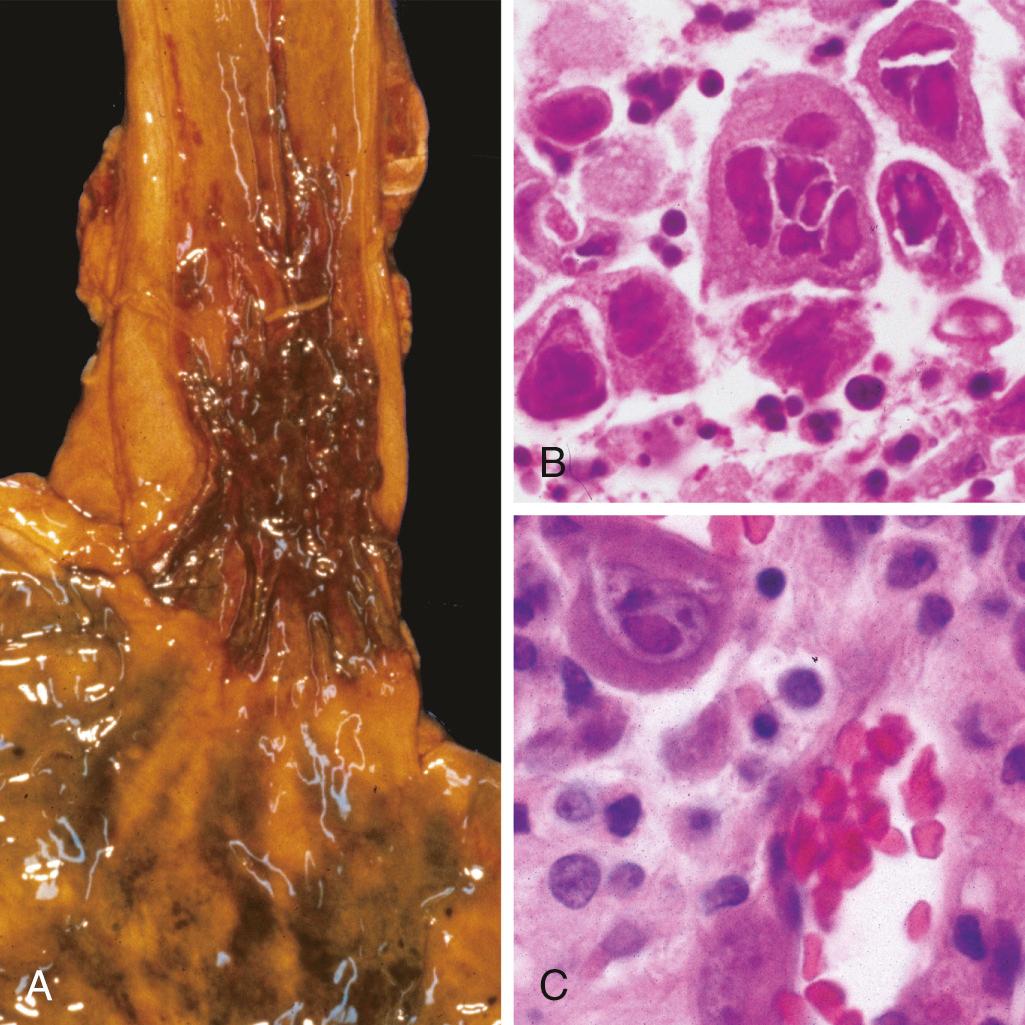
Reflux of gastric contents into the lower esophagus is the most frequent cause of esophagitis and the most common outpatient GI diagnosis in the United States. The associated clinical condition, termed gastroesophageal reflux disease (GERD), occurs because the esophageal epithelium is sensitive to acid despite being resistant to abrasive injury.
Transient lower esophageal sphincter relaxation is thought to be a major cause of GERD. This relaxation is mediated via vagal pathways and can be triggered by gastric distention. Gastroesophageal reflux can also occur following abrupt increases in intra-abdominal pressure, e.g., after coughing, straining, or bending. Other conditions that are associated with GERD include alcohol and tobacco use, obesity, central nervous system depressants, pregnancy, hiatal hernia (discussed later), delayed gastric emptying, and increased gastric volume.
Simple hyperemia, evident to the endoscopist as redness, may be the only alteration in mild GERD; mucosal histology is often unremarkable. More significant gastric reflux is associated with erosions ( Fig. 17.5A ) and influx of eosinophils into the squamous mucosa ( Fig. 17.6A ). Basal zone hyperplasia and elongation of lamina propria papillae are also common. Neutrophil infiltration is less frequent and is generally associated with bacterial or fungal infection or chemical damage.
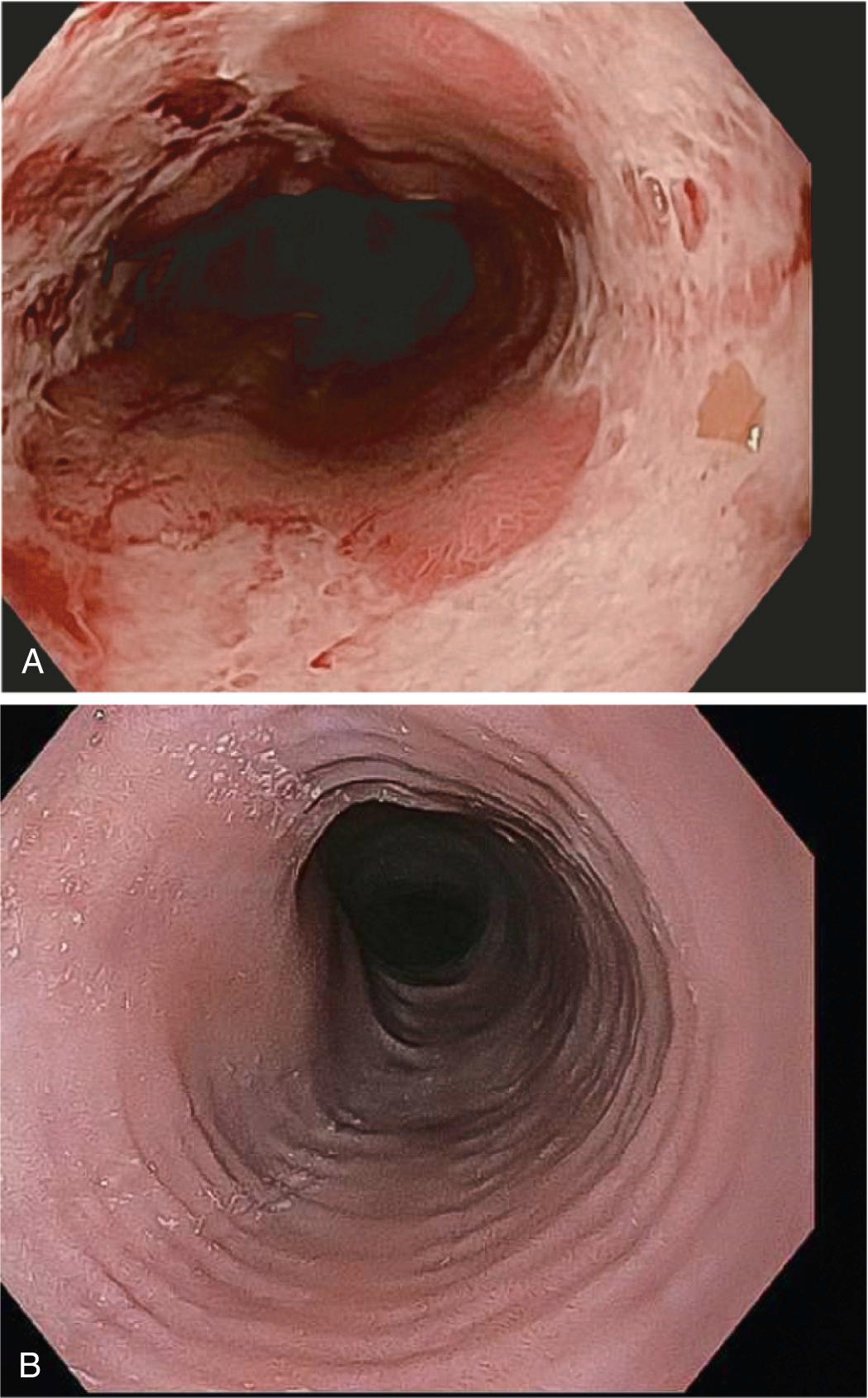
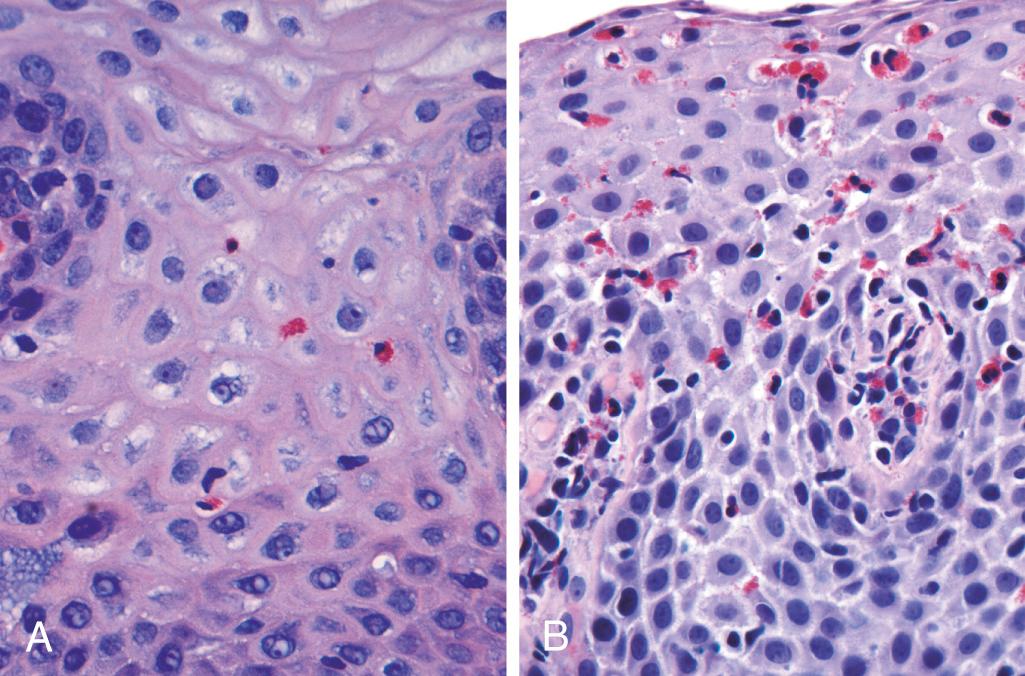
GERD has an estimated prevalence of 10% to 20% in the West, but less than 5% in Asia, and is most common in individuals older than age 40. Typical symptoms include heartburn, dysphagia, and regurgitation of sour-tasting gastric contents, most often postprandially. Rarely, GERD-associated chest pain may be mistaken for ischemic heart disease. Treatment with proton pump inhibitors to reduce gastric acidity typically provides symptomatic relief. Endoscopy is not required for the diagnosis and is usually reserved for those who are refractory to proton pump inhibitors. Endoscopic biopsy can also detect eosinophilic esophagitis as well as Barrett esophagus, strictures, ulcerations, and other GERD complications. Notably, the severity of symptoms is not closely related to the degree of histologic damage, and substantial histologic abnormalities may be found in those without typical GERD symptoms.
Hiatal hernia may cause lower esophageal sphincter incompetence and symptoms that are similar to GERD but it is symptomatic in fewer than 10% of adults. The majority of hiatal hernias are of the sliding type, in which the diaphragmatic crura are spread and the gastroesophageal junction herniates into the thorax. Less common paraesophageal hiatal hernias penetrate through a defect in the phrenoesophageal membrane, can involve the stomach and other organs, and generally require surgical repair.
Eosinophilic esophagitis is a form of acute eosinophil-dominated esophageal inflammation associated with atopic disease. Many patients have atopic dermatitis, allergic rhinitis, asthma, or modest peripheral eosinophilia. Consistent with this, recent data suggest that mast cells may also be important in pathogenesis. The incidence of eosinophilic esophagitis has increased dramatically, particularly in urban areas and among white males. In addition to GERD-like symptoms, patients experience food impaction, dysphagia, and vomiting. Infants may also suffer from feeding intolerance. On endoscopic examination the esophagus can take the appearance of stacked circular rings (referred to as feline esophagus because of supposed endoscopic resemblance to a striped cat’s tail), strictures, and linear furrows ( Fig. 17.5B ). The cardinal histologic feature is large numbers of intraepithelial eosinophils, particularly superficially, that can form clusters and sheets ( Fig. 17.6B ). Their abundance can help to distinguish eosinophilic esophagitis from GERD, Crohn disease, and other causes of esophagitis. However, these histologic findings are not entirely specific, and some patients with extensive intraepithelial eosinophil infiltration may respond to proton pump inhibitors, particularly when given at high doses. Dietary restrictions to prevent exposure to food allergens are often helpful and can be targeted on the basis of skin patch or immunoglobulin E (IgE) testing. Alternatively, empirical elimination of cow's milk, eggs, soy or legumes, and wheat from the diet can be beneficial. When dietary treatment fails, topical or, less frequently, systemic corticosteroids can be used and are sometimes combined with proton pump inhibitors. In contrast to GERD, eosinophilic esophagitis is not associated with increased risk of Barrett esophagus.
Esophageal varices are dilated veins within the lower esophagus. Although most small varices never bleed, rupture of large varices can result in exsanguination.
Esophageal varices are caused by portal hypertension, which is due to impaired blood flow through the portal venous system and liver. Increased portal venous pressure results in the development of collateral channels at sites where the portal and caval systems communicate. These collateral veins allow some drainage to occur, but also result in congestion and dilation of subepithelial and submucosal venous plexuses within the distal esophagus and proximal stomach. These dilated vessels, termed varices, are common in patients with cirrhosis, most frequently due to alcoholic liver disease. Worldwide, hepatic schistosomiasis is the second most common cause of varices. A more detailed consideration of portal hypertension is given in Chapter 18 .
Esophageal varices are tortuous dilated veins within the mucosa and submucosa of the distal esophagus and proximal stomach ( Fig. 17.7 ). Variceal rupture can result in hemorrhage into the lumen or the esophageal wall and may be associated with mucosal ulceration and necrosis. If rupture has occurred in the past, venous thrombosis, inflammation, and evidence of prior sclerotherapy may also be present.
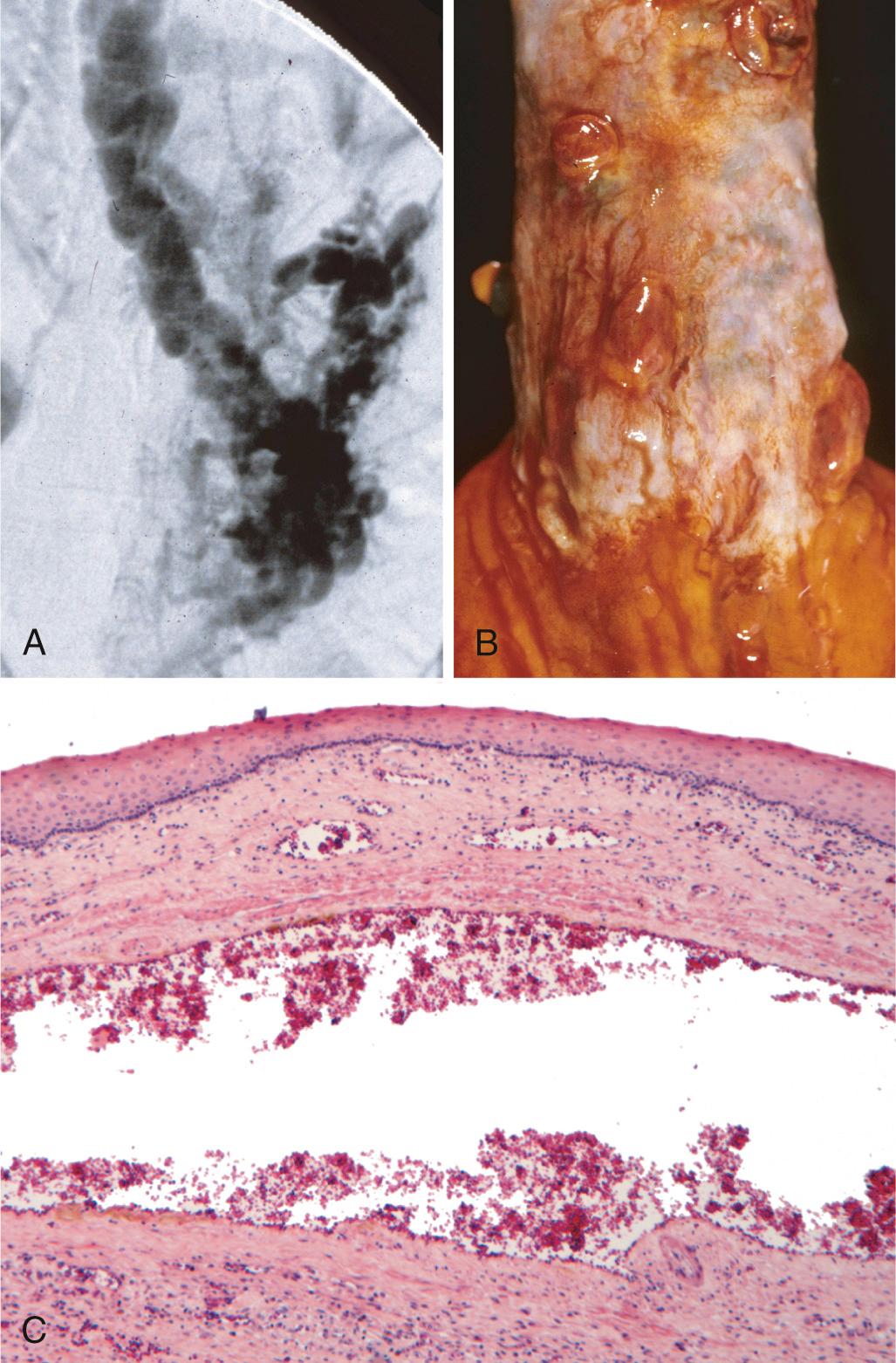
Gastroesophageal varices are present in 30% of those with compensated cirrhosis and in 60% of those with decompensated cirrhosis. Variceal hemorrhage is an emergency that can be treated medically by inducing splanchnic vasoconstriction or endoscopically by sclerotherapy (injection of thrombotic agents), balloon tamponade, or variceal ligation. Despite these interventions, each episode of variceal hemorrhage confers a 15% to 20% risk of mortality, and over half of patients who survive a first variceal bleed have recurrent hemorrhage within 1 year, with mortality risk similar to the first episode. Risk factors for hemorrhage include large or tortuous varices, elevated hepatic venous pressure gradient, previous bleeding, and advanced liver disease. Treatments include beta-blockers to reduce portal blood flow and endoscopic variceal ligation.
Barrett esophagus is a complication of chronic GERD that is characterized by intestinal metaplasia within the esophageal squamous mucosa and is associated with an increased risk of cancer. The incidence of Barrett esophagus is rising; it is estimated to occur in as many as 10% of individuals with symptomatic GERD and up to 2% of the general population. Barrett esophagus is most common in white males and typically presents between 40 and 60 years of age. The greatest clinical concern is that it confers an increased risk of esophageal adenocarcinoma. Genomic sequencing of biopsies involved by Barrett esophagus has revealed the presence of pathogenic driver mutations in cancer genes that are also found in esophageal adenocarcinoma. Potentially oncogenic mutations are more numerous when biopsies demonstrate dysplasia, a preinvasive neoplastic change that is associated with prolonged symptoms, longer segment length, increased patient age, and Caucasian race. The vast majority of esophageal adenocarcinomas occur in association with Barrett esophagus. Nevertheless, most individuals with Barrett esophagus do not develop esophageal tumors.
Barrett esophagus can be recognized as tongues of red, velvety mucosa extending upward from the gastroesophageal junction. This metaplastic mucosa alternates with residual smooth, pale squamous (esophageal) mucosa (see Fig. 17.5A ) and interfaces with light-brown columnar (gastric) mucosa distally ( Fig. 17.8A, B ). Barrett esophagus can be subclassified as long segment (≥3 cm), or short segment (<3 cm). Patients with short-segment disease may not experience GERD symptoms and are at lower risk of developing dysplasia or carcinoma relative to those with long-segment disease.
Diagnosis of Barrett esophagus requires endoscopic evidence of metaplastic columnar mucosa above the gastroesophageal junction. Microscopically, intestinal-type metaplasia is seen as replacement of the squamous esophageal epithelium with goblet cells. Goblet cells are diagnostic of Barrett esophagus and have distinct mucous vacuoles that stain pale blue and impart the shape of a wine goblet to the remaining cytoplasm ( Fig. 17.8C ). Non-goblet columnar cells, such as gastric-type foveolar cells, may also be present, but there is not universal agreement as to whether they are sufficient for the diagnosis.
Dysplasia is classified as low grade or high grade. Atypical mitoses, nuclear hyperchromasia, irregularly clumped chromatin, increased nuclear-to-cytoplasmic ratio, and failure of epithelial cells to mature as they migrate to the esophageal surface are present in both grades ( Fig. 17.9A ). Dysplastic glands display budding, irregular shapes, and cellular crowding. High-grade dysplasia ( Fig. 17.9B ) exhibits more severe cytologic and architectural changes than low-grade dysplasia. With progression, epithelial cells may invade the lamina propria, a feature that defines progression to intramucosal carcinoma.
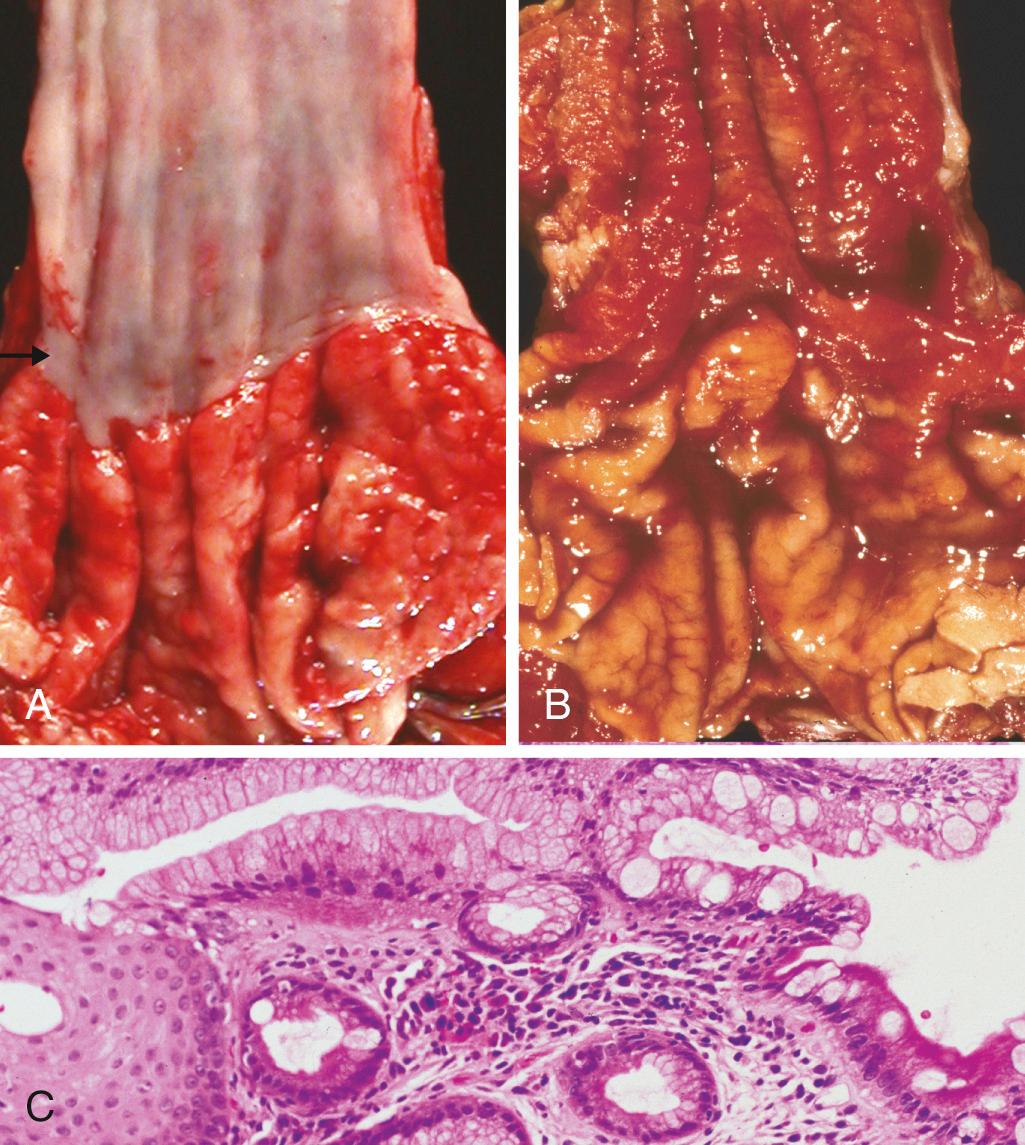
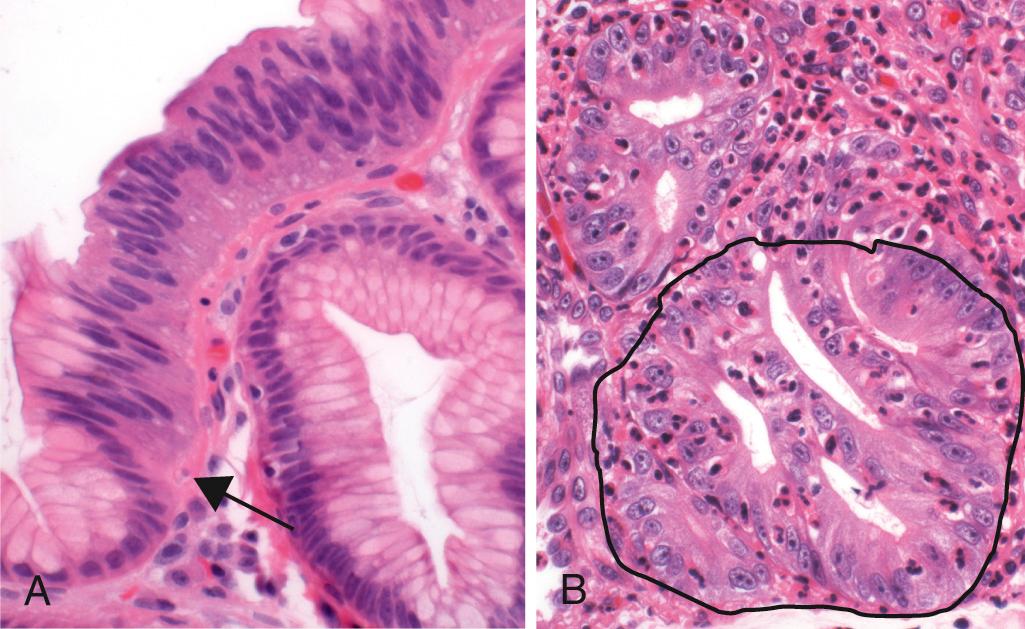
Barrett esophagus can be identified only thorough endoscopy and biopsy, which are usually prompted by GERD symptoms. Once diagnosed, the best course of management is a matter of debate. Many support surveillance by periodic endoscopy with biopsy, but randomized trials have failed to demonstrate that this improves overall survival. Furthermore, uncertainties regarding the potential of dysplasia, particularly low-grade dysplasia, to regress spontaneously and limited information on the risk of progression complicate clinical decisions.
Intramucosal or invasive carcinoma requires therapeutic intervention. Treatment options include surgical resection, or esophagectomy, as well as newer modalities such as photodynamic therapy, laser ablation, and endoscopic mucosectomy. Multifocal high-grade dysplasia, which carries a significant risk of progression to intramucosal or invasive carcinoma, is treated as intramucosal carcinoma. At present, many physicians follow low-grade dysplasia or a single focus of high-grade dysplasia with endoscopy and biopsy at regular intervals.
Nearly all esophageal cancers are either adenocarcinoma or squamous cell carcinoma. Squamous cell carcinoma is more common worldwide, but adenocarcinoma is on the rise in the United States and other Western countries. Other malignancies of the esophagus are far less common and include unusual forms of adenocarcinoma, undifferentiated carcinoma, neuroendocrine carcinoma, melanoma, lymphoma, and sarcoma; these are not discussed here. Benign tumors of the esophagus are generally mesenchymal, and arise within the esophageal wall, with leiomyomas being most common.
Esophageal adenocarcinoma typically arises in the background of Barrett esophagus and long-standing GERD. Thus, increased rates of esophageal adenocarcinoma may be partly due to the increased incidence of obesity-related gastroesophageal reflux and associated Barrett esophagus. Other major risk factors include tobacco use and exposure to radiation. Conversely, risk is reduced by diets rich in fresh fruits and vegetables. Some serotypes of Helicobacter pylori are associated with decreased risk of esophageal adenocarcinoma, perhaps because they cause gastric atrophy, which decreases acid secretion and reduces reflux-induced esophageal damage.
Esophageal adenocarcinoma occurs most frequently in Caucasians and shows a strong gender bias, being sevenfold more common in men. The incidence varies widely worldwide, with rates being highest in the United States, the United Kingdom, Canada, Australia, the Netherlands, and Brazil and lowest in Korea, Thailand, Japan, and Ecuador. In countries where esophageal adenocarcinoma is more common, the incidence has increased markedly since 1970, more rapidly than almost any other cancer. For unknown reasons, these increases have been restricted to white and Hispanic men and white women in the United States. As a result, esophageal adenocarcinoma, which represented less than 5% of esophageal cancers before 1970, now accounts for more than half of all esophageal cancers in the United States.
Molecular studies indicate that progression of Barrett esophagus to adenocarcinoma occurs over an extended period through the stepwise acquisition of genetic and epigenetic changes. Chromosomal abnormalities and mutations of the tumor suppressor genes TP53 and CDKN2A are detected at early stages. In the case of CDKN2A, which you will recall encodes two tumor suppressor proteins, p16 and p19-ARF, both allelic loss and hypermethylation-induced epigenetic silencing have been described. With progression, there may be amplification of several oncogenes, including the EGFR, ERBB2, MET, cyclin D1, and cyclin E genes.
Esophageal adenocarcinoma usually occurs in the distal third of the esophagus and may invade the adjacent gastric cardia ( Fig. 17.10A ). It initially appears as flat or raised patches in otherwise intact mucosa, and may grow into large masses of 5 cm or more in diameter. Alternatively, tumors may infiltrate diffusely or ulcerate and invade deeply.
Microscopically, tumors typically produce mucin and form glands ( Fig. 17.11A ), often with intestinal-type morphology; less frequently, tumors are composed of diffusely infiltrative signet-ring cells (similar to those seen in diffuse gastric cancers) or, in rare cases, small poorly differentiated cells (similar to small cell carcinoma of the lung). Barrett esophagus is frequently present adjacent to the tumor.
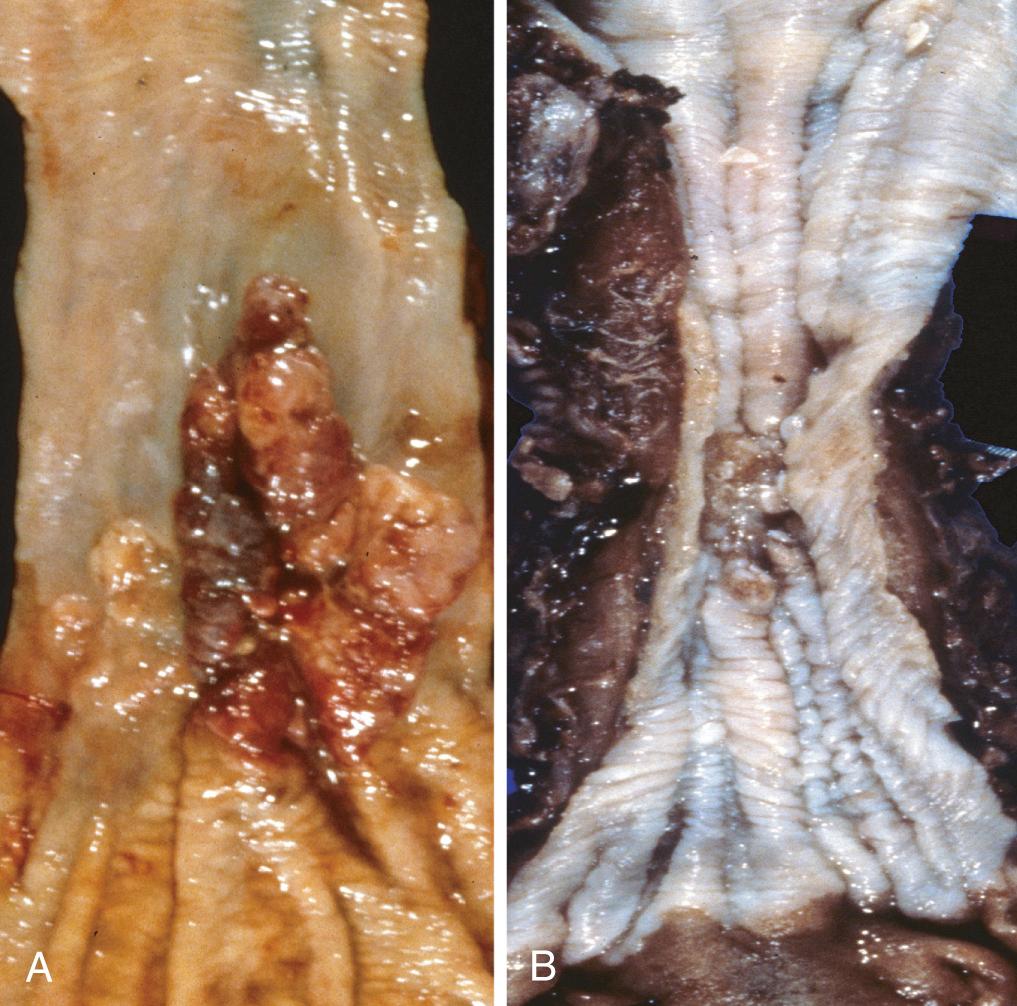
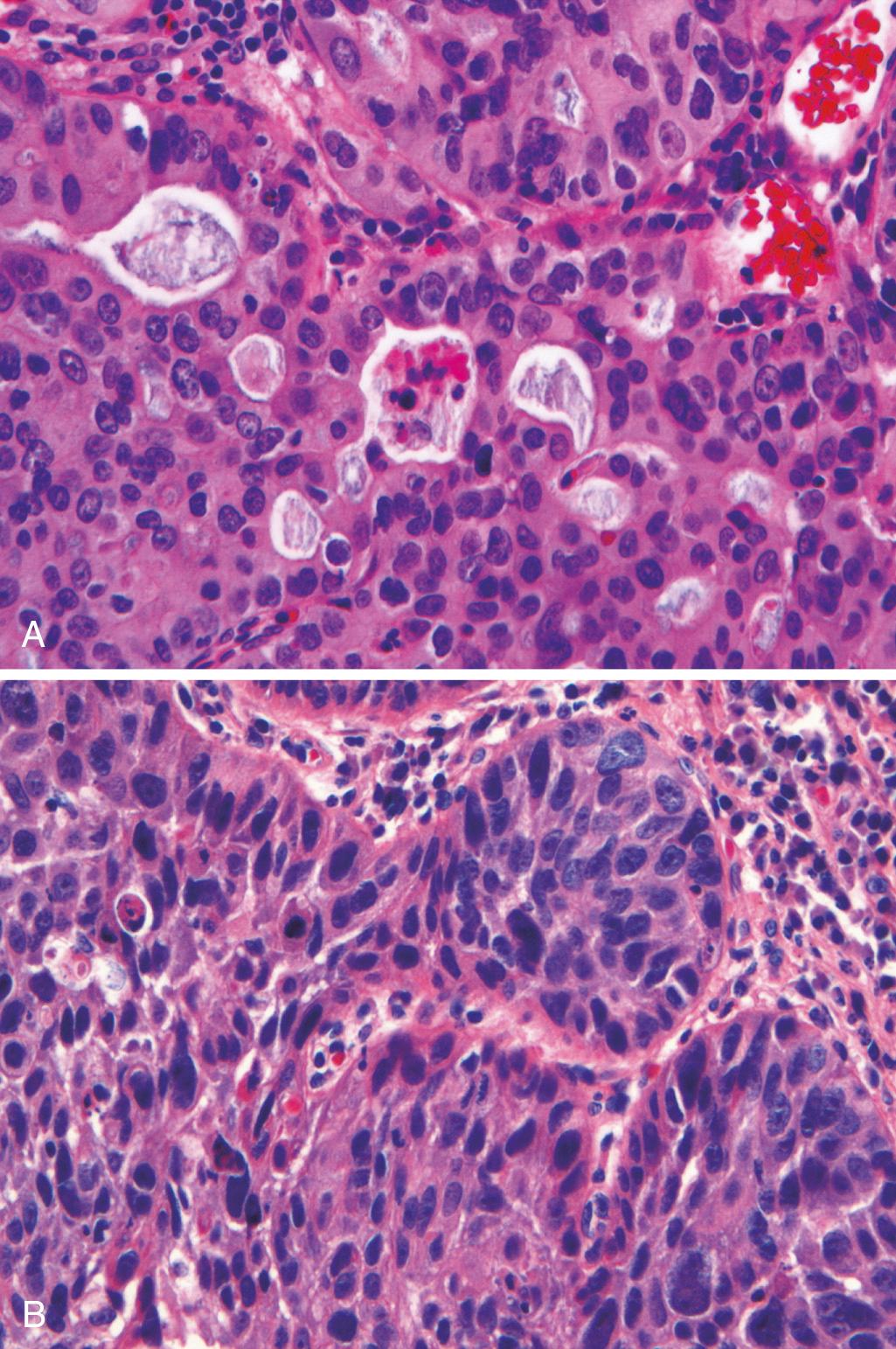
Although esophageal adenocarcinomas are occasionally discovered incidentally during the evaluation of GERD or surveillance of Barrett esophagus, they more commonly present with pain or difficulty in swallowing, progressive weight loss, hematemesis, chest pain, or vomiting. By the time symptoms appear, the tumor has often spread to submucosal lymphatic vessels. As a result, overall 5-year survival is less than 25%. In contrast, 5-year survival is approximately 80% in cases in which adenocarcinoma is limited to the mucosa or submucosa.
In the United States, esophageal squamous cell carcinoma occurs in adults older than age 45 and affects males four times more frequently than females. Risk factors include alcohol and tobacco use, poverty, caustic esophageal injury, achalasia, Plummer-Vinson syndrome, diets that are deficient in fruits or vegetables, and frequent consumption of very hot beverages. Previous radiation to the mediastinum also predisposes individuals to esophageal carcinoma, with most cases occurring 5 to 10 or more years after exposure.
Esophageal squamous cell carcinoma incidence varies up to 180-fold between and within countries, being more common in rural and low income populations. The regions with highest incidence are Iran, central China, Hong Kong, Brazil, and South Africa. A pocket of extremely high incidence in western Kenya has been linked to consumption of a traditional fermented milk, termed mursik, which contains the carcinogen acetaldehyde ( Chapter 9 ). In other geographic areas with high esophageal squamous cell carcinoma rates, regular ingestion of very hot tea is common. In the United States, it is nearly eightfold more frequent in African Americans than in Caucasians, a striking risk disparity that partially reflects differences in rates of alcohol and tobacco use but likely also reflects contributions of other factors that remain poorly understood.
The majority of esophageal squamous cell carcinomas in Europe and the United States are linked to alcohol and tobacco use, which synergize to increase the risk. However, esophageal squamous cell carcinoma is also common in some regions where alcohol and tobacco use is uncommon. Thus, nutritional deficiencies, as well as polycyclic hydrocarbons, nitrosamines, and other mutagenic compounds, such as those found in fungus-contaminated foods must be considered. Some data suggest that human papillomavirus (HPV) infection may contribute to esophageal squamous cell carcinoma in high-risk, but not in low-risk, regions. The molecular pathogenesis of esophageal squamous cell carcinoma remains incompletely defined, but recurrent abnormalities include amplification of the transcription factor gene SOX2, which is involved in stem cell self-renewal; overexpression of the cell cycle regulator cyclin D1; and loss-of-function mutations in the tumor suppressor genes TP53, CDH1 (which encodes E-cadherin), and NOTCH1 .
In contrast to the distal location of adenocarcinoma, half of squamous cell carcinomas occur in the middle third of the esophagus ( Fig. 17.10B ). Squamous cell carcinoma begins as an in situ lesion termed squamous dysplasia (this histopathology is referred to as intraepithelial neoplasia or carcinoma in situ at sites outside the GI tract, e.g., uterine cervix). Early lesions appear as small, gray-white, plaque-like thickenings. Over months to years they grow into tumor masses that may be polypoid, or exophytic, and protrude into and obstruct the lumen. Other tumors are ulcerated or diffusely infiltrative lesions that spread within the esophageal wall and cause thickening, rigidity, and luminal narrowing. Tumors may invade surrounding structures including the respiratory tree (causing pneumonia), the aorta (causing catastrophic exsanguination), or the mediastinum and pericardium.
Most squamous cell carcinomas are moderately to well differentiated ( Fig. 17.11B ). Less common histologic variants include verrucous squamous cell carcinoma, spindle cell carcinoma, and basaloid squamous cell carcinoma. Regardless of histology, symptomatic tumors are generally large and invasive at diagnosis. The rich lymphatic network of the esophagus promotes metastases as well as circumferential and longitudinal spread; intramural satellite tumor nodules may be present several centimeters away from the principal mass. The sites of lymph node metastases vary with tumor location: cancers in the upper third of the esophagus favor cervical lymph nodes; those in the middle third favor mediastinal, paratracheal, and tracheobronchial nodes; and those in the lower third spread to gastric and celiac nodes.
The onset of esophageal squamous cell carcinoma is insidious. Patients typically have dysphagia, odynophagia (pain on swallowing), or obstruction at presentation and may have unknowingly adjusted to progressive esophageal obstruction by altering their diet from solid to liquid foods. Weight loss and debilitation result from both impaired nutrition and tumor cachexia. Hemorrhage and sepsis may accompany tumor ulceration, and symptoms of iron deficiency are often present. Occasionally, the first symptoms are caused by aspiration of food via a tracheoesophageal fistula (caused by extension of the tumor into the trachea).
Increased prevalence of endoscopic screening has led to earlier detection of esophageal squamous cell carcinoma. This is significant because 5-year survival rates are 75% in individuals with superficial lesions but much lower in patients with more advanced tumors. Lymph node metastases are associated with poor prognosis. The overall 5-year survival rate in the United States remains less than 20% and varies by tumor stage and patient age, race, and sex.
Abnormalities of esophageal motility include nutcracker esophagus and diffuse esophageal spasm.
Achalasia, characterized by incomplete lower esophageal sphincter relaxation, increased lower esophageal sphincter tone, and esophageal aperistalsis, is a common form of functional esophageal obstruction. It can be primary or secondary, with the latter form most commonly due to Trypanosoma cruzi infection.
Mallory-Weiss tears of mucosa at the gastroesophageal junction develop as a result of severe retching or vomiting.
Esophagitis can result from chemical or infectious mucosal injury. Infection is most common in immunocompromised individuals.
The most prevalent cause of esophagitis is reflux of gastric acid into the esophagus (GERD).
Eosinophilic esophagitis is strongly associated with food allergy, allergic rhinitis, or asthma. It is a common cause of GERD-like symptoms in children living in high income countries.
Gastroesophageal varices are a consequence of portal hypertension and are present in half of cirrhosis patients.
Barrett esophagus develops in patients with chronic GERD and represents columnar metaplasia of the esophageal squamous mucosa.
Barrett esophagus is a risk factor for development of esophageal adenocarcinoma.
Esophageal squamous cell carcinoma is associated with alcohol and tobacco use, poverty, caustic esophageal injury, achalasia, tylosis, and Plummer-Vinson syndrome.
Disorders of the stomach are a frequent cause of clinical disease, with inflammatory and neoplastic lesions being most common. In the United States, diseases related to the stomach account for nearly one-third of all health care spending on GI disease. In addition, despite decreasing incidence in certain locales such as the United States, gastric cancer remains a leading cause of death worldwide.
The stomach is divided into four major anatomic regions: cardia, fundus, body, and antrum. The cardia and antrum are lined mainly with mucin-secreting foveolar cells that form small glands. The antral glands are similar but also contain endocrine cells such as G cells that release gastrin to stimulate luminal acid secretion by parietal cells within the gastric fundus and body. The well-developed glands of the body and fundus contain parietal cells as well as chief cells that produce and secrete digestive enzymes.
Inflammation of the gastric mucosa occurs in many conditions, and is called acute gastritis when neutrophils are present and gastropathy when inflammatory cells are rare or absent. Irritants including non-steroidal anti-inflammatory drugs (NSAIDs), alcohol, and bile are the most common causes of gastropathy. Both gastropathy and gastritis may be asymptomatic or associated with epigastric pain, nausea, and vomiting. In more severe cases there may be mucosal erosion, ulceration, hemorrhage, hematemesis, melena, or, rarely, massive blood loss.
The gastric lumen has a pH of close to 1, more than a million times more acidic than the blood. This harsh environment contributes to digestion but also has the potential to cause damage. Multiple mechanisms have evolved to protect the gastric mucosa ( Fig. 17.12 ). Foveolar cell secretions form a thin layer of mucus and phospholipids that prevents large food particles from directly touching the epithelium. Mucus also promotes formation of an “unstirred” layer of fluid with a neutral pH as a result of bicarbonate ion secretion by surface epithelial cells. Beneath the mucus, gastric epithelial cells form a physical barrier that limits back diffusion of acid and leakage of other luminal materials, including digestive enzymes, into the lamina propria. Surface foveolar cells are replaced every 3 to 7 days, while parietal and chief cells are more long-lived. The rich mucosal vasculature delivers oxygen and nutrients and removes whatever gastric acid may have diffused into the lamina propria.
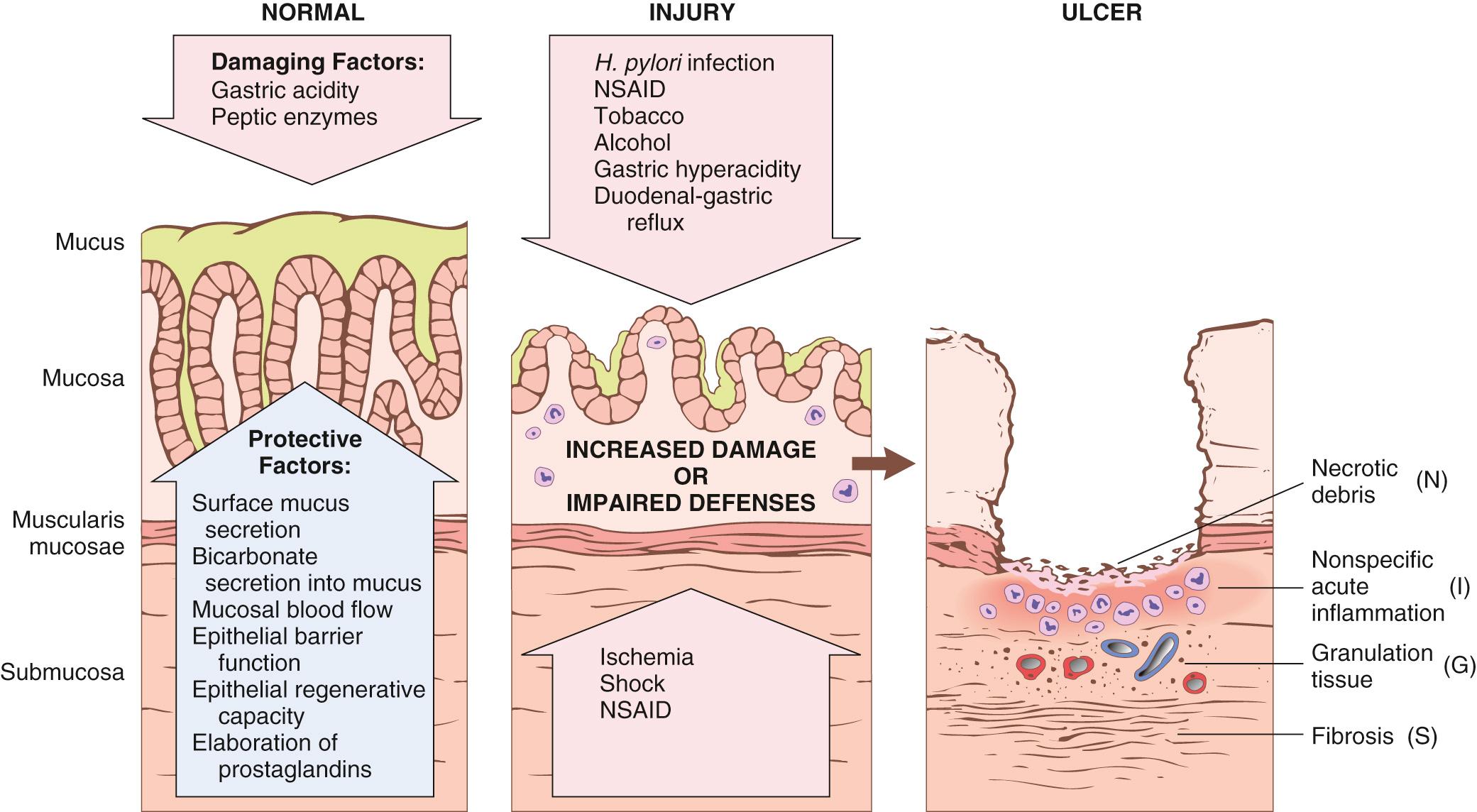
Gastropathy and gastritis occur when the damaging forces overwhelm the protective factors ( Fig. 17.12 ). Disruption of protective mechanisms is illustrated by the following examples:
Inhibition of cyclooxygense (COX) by NSAIDs. NSAIDs inhibit COX-dependent synthesis of prostaglandins E 2 and I 2 , which contribute to nearly all of the above defense mechanisms, including: mucus, bicarbonate, and phospholipid secretion; mucosal blood flow; and epithelial restitution. They also reduce acid secretion. Although COX-1 plays a larger role than COX-2, both isoenzymes contribute to mucosal protection. Thus, while the risk of NSAID-induced gastric injury is greatest with nonselective inhibitors such as aspirin, ibuprofen, and naproxen, selective COX-2 inhibitors such as celecoxib can also cause gastropathy or gastritis.
Inhibition of gastric bicarbonate transporters by ammonium ions can result in gastric injury in uremic patients and those infected with urease-secreting H. pylori.
Reduced mucin and bicarbonate secretion have been suggested as factors that explain the increased susceptibility of older adults to gastritis.
Decreased oxygen delivery may account for an increased incidence of acute gastritis at high altitudes.
Ingestion of harsh chemicals, particularly acids or bases, either accidentally or as a suicide attempt, causes severe gastric injury. Direct cellular damage also contributes to gastritis induced by alcohol consumption, NSAIDs, radiation therapy, and chemotherapy. Agents that inhibit DNA synthesis or the mitotic apparatus, including those used in cancer chemotherapy, may cause generalized mucosal damage by inhibiting epithelial renewal.
Histologically, gastropathy and mild acute gastritis may be difficult to recognize, since the lamina propria shows only moderate edema and slight vascular congestion. The surface epithelium is intact, but foveolar cell hyperplasia, with characteristic corkscrew profiles and epithelial proliferation, is often present. Neutrophils may be found among the epithelial cells or within mucosal gland lumina in gastritis. The lamina propria contains only a few lymphocytes and plasma cells.
The presence of neutrophils above the basement membrane in direct contact with epithelial cells is abnormal in all parts of the GI tract and signifies active inflammation, or, in this case, gastritis (rather than gastropathy). The term active inflammation is preferred over acute inflammation, since neutrophils may be present in both acute and chronic disease states. Thus, within the GI tract, the term acute refers to disease duration rather than the inflammatory pattern.
As injury progresses, erosions, i.e., superficial mucosal defects, are accompanied by neutrophilic infiltrates and fibrin-containing exudate within the lumen. Hemorrhage may cause dark puncta within hyperemic mucosa. Concurrent erosion and hemorrhage is termed acute erosive hemorrhagic gastritis. Although large areas of the gastric surface may be denuded, the involvement is typically superficial.
Stress-related mucosal disease occurs in patients with severe trauma, extensive burns, intracranial disease, major surgery, serious medical disease, and other forms of severe physiologic stress. In some cases, stress-related ulcers are given specific names based on location and clinical associations. For example:
Stress ulcers are most common in the setting of shock, sepsis, or severe trauma.
Curling ulcers refer to ulcers occurring in the proximal duodenum in the context of severe burns or trauma.
Cushing ulcers refer to gastric, duodenal, and esophageal ulcers arising in those with intracranial disease. They have an elevated risk of perforation.
The pathogenesis of stress-related gastric mucosal injury is most often related to local ischemia. This may be due to systemic hypotension or reduced blood flow caused by stress-induced splanchnic vasoconstriction. Upregulation and increased release of the vasoconstrictor endothelin-1 also contribute to ischemic gastric mucosal injury.
Lesions associated with intracranial injury are thought to be caused by direct stimulation of vagal nuclei, which causes hypersecretion of gastric acid. Systemic acidosis, a frequent finding in these settings, may also contribute to mucosal injury by lowering the intracellular pH of mucosal cells and reducing the pH gradient that promotes washout of acid that has back-diffused into the lamina propria.
Stress-related gastric mucosal injury ranges from shallow erosions to lesions that penetrate the mucosa. Ulcers are rounded, less than 1 cm in diameter, and have a base that is frequently stained brown to black by acid digestion of extravasated blood. Unlike peptic ulcers, which are usually solitary and located in the antrum, acute stress ulcers are found anywhere in the stomach and are often multiple. Microscopically, acute stress ulcers are sharply demarcated, with relatively normal adjacent mucosa. Serositis may be present, but the scarring and blood vessel thickening that characterize chronic peptic ulcers are conspicuously absent. Healing with complete re-epithelialization occurs within days to weeks after successful treatment of the underlying condition.
Most critically ill patients admitted to hospital intensive care units have histologic evidence of gastric mucosal damage. Bleeding from these lesions is sufficiently severe to require red cell transfusions in 1% to 4% of such patients. Other complications, including perforation, can also occur. Prophylactic proton pump inhibitors may blunt the impact of stress ulceration, but the most important determinant of clinical outcome is whether the underlying condition can be corrected.
Non–stress-related causes of gastric bleeding include the following two conditions:
Dieulafoy lesion consists of an abnormal submucosal arteriole that is usually found within the lesser curvature of the stomach near the gastroesophageal junction. Erosion of the overlying epithelium can cause recurrent gastric bleeding that, while usually self-limited, can be copious. NSAID use may enhance bleeding risk.
Gastric antral vascular ectasia (GAVE) is responsible for 4% of non-variceal upper GI bleeding. It can be recognized endoscopically as longitudinal stripes of edematous, erythematous mucosa that alternate with less severely injured, paler mucosa and is sometimes referred to as watermelon stomach. The erythematous stripes are created by ectatic mucosal vessels. Histologically, the antral mucosa shows reactive gastropathy with dilated capillaries containing fibrin thrombi. While most often idiopathic, GAVE can be associated with cirrhosis and systemic sclerosis. Recurrent bleeding may produce a positive test for fecal blood and lead to iron deficiency anemia.
Chronic gastritis is most often caused by H. pylori infection. Other causes include autoimmune gastritis; radiation injury; chronic bile reflux; mechanical injury (e.g., an indwelling nasogastric tube); and involvement by systemic diseases such as Crohn disease, amyloidosis, or graft-versus-host disease.
Relative to acute gastritis, the symptoms associated with chronic gastritis are typically less severe but more persistent. Nausea and upper abdominal pain are typical, sometimes with vomiting, but hematemesis is uncommon.
H. pylori are spiral-shaped or curved bacilli present in gastric biopsy specimens of almost all patients with duodenal ulcers as well as most individuals with gastric ulcers or chronic gastritis. Acute H. pylori infection does not produce sufficient symptoms to come to medical attention in most cases; it is the chronic gastritis that ultimately causes the individual to seek treatment. H. pylori organisms are present in the majority of individuals with chronic antral gastritis.
In the United States, H. pylori infection is associated with poverty, household crowding, limited education, residence in rural areas, birth outside of the United States, and age over 60 years. The prevalence of infection is also greater in those of African American or Mexican American ethnicity as well as some immigrant populations. Humans are the primary carriers, suggesting that transmission is primarily by the fecal-oral route. Infection is typically acquired in childhood and persists for life without treatment. Improved sanitation explains the marked reduction in H. pylori infection rates among younger people. In well-resourced countries, H. pylori infection is currently uncommon before 10 years of age, is found in only 10% of those between the ages of 18 and 30 years, but is present in up to 50% of those older than 65. It follows that environment during childhood is a critical risk factor for H. pylori colonization.
H. pylori infection most often presents as a predominantly antral gastritis with normal or increased acid production. When inflammation remains limited to the antrum, modestly increased local gastrin production can augment parietal cell mass within the gastric body and increase acid secretion that leads to greater risk of gastric or duodenal peptic ulcer disease (see later). Alternatively, long-standing H. pylori gastritis may progress to involve the gastric body and fundus. This may result in atrophic gastritis with reduced parietal cell mass and intestinal metaplasia. In contrast to autoimmune gastritis (see later), atrophy induced by H. pylori is not associated with autoantibodies and is typically patchy. The loss of parietal cells leads to reduced acid secretion that, in turn, stimulates gastrin production. However, because some parietal cells survive, limited acid secretion continues and gastrin increases are not as great as those in autoimmune gastritis. Nevertheless, decreased acid secretion in H. pylori gastritis with atrophy reduces the risk of gastric and duodenal ulcers. This results in an inverse relationship between gastric adenocarcinoma, which is associated with atrophy and intestinal metaplasia, and duodenal ulcers, which are associated with increased acid secretion.
H. pylori organisms have adapted to the ecologic niche provided by gastric mucus. Its virulence is linked to the following factors:
Flagella, which allow the bacteria to be motile in viscous mucus
Urease, which generates ammonia from endogenous urea and thereby elevates local gastric pH and enhances bacterial survival
Adhesins that enhance bacterial adherence to surface foveolar cells
Toxins, such as cytotoxin-associated gene A (CagA)
Variation in these and other bacterial factors are strongly linked to outcome. For example, the CagA gene is present in 50% of H. pylori isolates overall but in 90% of H. pylori isolates in populations with an increased prevalence of gastric cancer. This may, in part, be because CagA -expressing strains colonize the gastric body and induce proinflammatory cytokine secretion, atrophy, and intestinal metaplasia more effectively than CagA -negative H. pylori .
Host factors also play an important role in the outcome of H. pylori infection. Genetic polymorphisms that lead to increased expression of the proinflammatory cytokines tumor necrosis factor (TNF) and interleukin (IL)-1β or decreased expression of the anti-inflammatory cytokine IL-10 seem to be associated with development of pangastritis, atrophy, intestinal metaplasia, and gastric cancer. The course of H. pylori gastritis is, therefore, the result of interplay between gastroduodenal mucosal defenses, host immune responses, and bacterial virulence factors.
Gastric biopsy specimens generally demonstrate H. pylori in infected individuals. The organism is concentrated within the superficial mucus overlying epithelial cells in the surface and neck regions. The distribution can be irregular, with areas of heavy colonization adjacent to those with few organisms. Organisms are most easily demonstrated with immunostains or histochemical stains ( Fig. 17.13A ).
The antrum is the preferred biopsy site for evaluation of H. pylori gastritis because it is most commonly infected. In dense colonization, organisms may also be found in oxyntic (acid-producing) mucosa of the fundus and body. H. pylori –infected antral mucosa is usually erythematous and has a coarse or even nodular appearance. The inflammatory infiltrate includes large numbers of plasma cells, often in clusters or sheets, within the superficial lamina propria. These are accompanied by increased numbers of lymphocytes, macrophages, and neutrophils within the lamina propria. Neutrophils infiltrate across the basement membrane ( Fig. 17.13B ) and accumulate in the lumens of gastric glands, or pits, to create pit abscesses. When intense, inflammatory infiltrates may create thickened rugal folds, mimicking the endoscopic appearance of early cancers. Lymphoid aggregates, some with germinal centers, are frequently present ( Fig. 17.13C ) and represent induced mucosa-associated lymphoid tissue (MALT) that has the potential to transform into lymphoma. Thus, chronic H. pylori gastritis is associated with increased risk of both gastric adenocarcinoma and lymphoma.
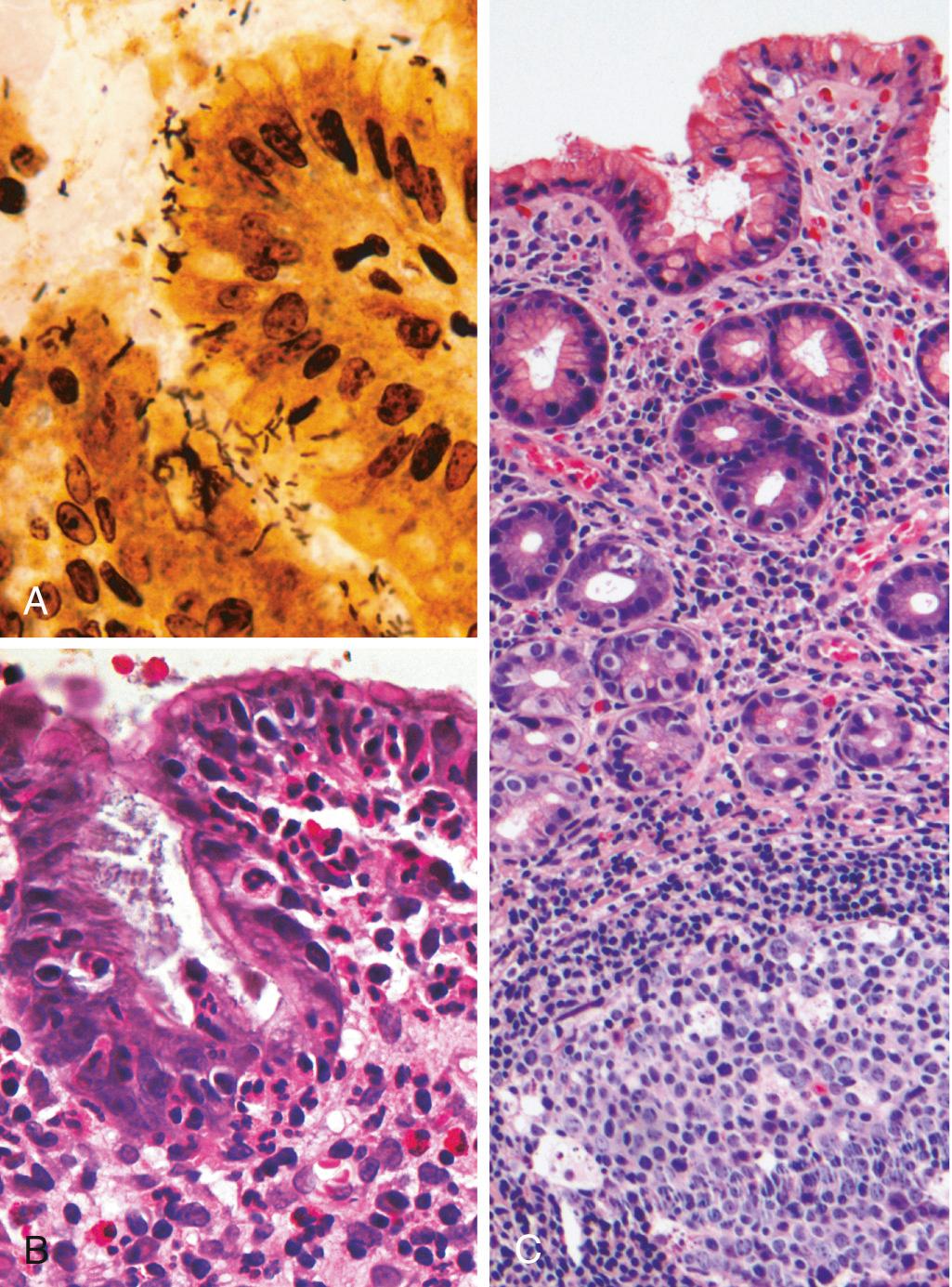
The changes seen in atrophic H. pylori gastritis are sometimes referred to as environmental metaplastic atrophic gastritis, to distinguish it from autoimmune metaplastic atrophic gastritis (described next). In addition to histologic identification of the organism, several noninvasive diagnostic tests have been developed, including serology for antibodies to H. pylori, fecal bacterial detection, and the urea breath test, which is positive due to ammonia produced by the bacterial urease. Other diagnostic tests performed on biopsies include the rapid urease test, bacterial culture, or polymerase chain reaction (PCR)-based detection of H. pylori DNA.
Effective treatments for H. pylori infection include combinations of antibiotics and proton pump inhibitors. Individuals with H. pylori gastritis usually improve after treatment, although relapses can occur after incomplete eradication or re-infection, particularly in regions with high endemic colonization rates.
Autoimmune atrophic gastritis, in contrast to H. pylori –associated gastritis, typically spares the antrum and is often associated with marked hypergastrinemia ( Table 17.2 ). It accounts for less than 10% of cases of chronic gastritis and has an estimated prevalence of 2% in those over 60 years of age. Autoimmune atrophic gastritis is characterized by:
Antibodies to parietal cells and intrinsic factor that can be detected in serum and gastric secretions
Reduced serum pepsinogen I concentration
Endocrine cell hyperplasia
Vitamin B 12 deficiency
Defective gastric acid secretion (achlorhydria)
| H. pylori– Associated | Autoimmune | |
|---|---|---|
| Location | Antrum | Body |
| Inflammatory infiltrate | Neutrophils, subepithelial plasma cells | Lymphocytes, macrophages |
| Acid production | Increased to slightly decreased | Decreased |
| Gastrin secretion | Normal to increased | Increased to markedly increased |
| Other lesions | Hyperplastic/inflammatory polyps | Neuroendocrine hyperplasia |
| Serology | Antibodies to H. pylori | Antibodies to parietal cells (H + ,K + -ATPase, intrinsic factor) |
| Sequelae | Peptic ulcer, adenocarcinoma, MALToma | Atrophy, pernicious anemia, adenocarcinoma, carcinoid tumor |
| Associations | Low socioeconomic status, poverty, residence in rural areas | Autoimmune disease: thyroiditis, diabetes mellitus, Graves disease |
Autoimmune atrophic gastritis is associated with loss of parietal cells, which are responsible for secretion of gastric acid and intrinsic factor. The absence of acid production stimulates gastrin release, resulting in hypergastrinemia and hyperplasia of antral gastrin-producing G cells. Intrinsic factor loss results in defective ileal vitamin B 12 absorption, which ultimately leads to vitamin B 12 deficiency and pernicious anemia (a form of megaloblastic anemia described in Chapter 14 ). The high frequency of associated intestinal metaplasia has led to the term autoimmune metaplastic atrophic gastritis .
CD4+ T cells directed against parietal cell components, including hydrogen potassium adenosine triphosphatase (H + ,K + -ATPase), are considered to be the principal agents of injury in autoimmune atrophic gastritis. This is supported by the observation that transfer of H + ,K + -ATPase–reactive CD4+ T cells into naïve mice results in gastritis and production of H + ,K + -ATPase autoantibodies. There is no evidence of an autoimmune reaction to chief cells, suggesting that these may be lost through gastric gland destruction during autoimmune attack on parietal cells. If autoimmune destruction is controlled by immunosuppression, the glands can repopulate, demonstrating that gastric stem cells survive and are able to differentiate into parietal and chief cells.
Autoantibodies to parietal cell components, most prominently H + ,K + -ATPase, or proton pump, and intrinsic factor are present in up to 80% of patients with autoimmune atrophic gastritis. However, these antibodies are not thought to be pathogenic because neither secreted intrinsic factor nor the luminally oriented proton pump is accessible to circulating antibodies, and passive transfer of these antibodies does not produce gastritis in experimental animals.
Autoimmune atrophic gastritis is characterized by diffuse damage to the oxyntic (acid-producing) mucosa within the body and fundus. The antrum and cardia are typically spared. With diffuse atrophy, oxyntic mucosa of the body and fundus appears markedly thinned, and rugal folds are lost. If vitamin B 12 deficiency is severe, nuclear enlargement (megaloblastic change) occurs within epithelial cells. Neutrophils may be present, but the inflammatory infiltrate is typically composed of lymphocytes, macrophages, and plasma cells, often in association with lymphoid aggregates and follicles. In contrast to the superficial lamina propria inflammation that is typical of H. pylori gastritis, inflammation in autoimmune atrophic gastritis is deeper and centered on the gastric glands ( Fig. 17.14A ). Loss of parietal and chief cells can be extensive. When atrophy is incomplete, residual islands of oxyntic mucosa may give the appearance of multiple small polyps or nodules. In other areas, small surface elevations may represent sites of intestinal metaplasia, characterized by the presence of goblet cells and columnar absorptive cells ( Fig. 17.14B ). Endocrine and enterochromaffin-like cell hyperplasia is commonly present. Rarely, endocrine cell hyperplasia may progress to form small, multicentric, low-grade neuroendocrine (carcinoid) tumors.
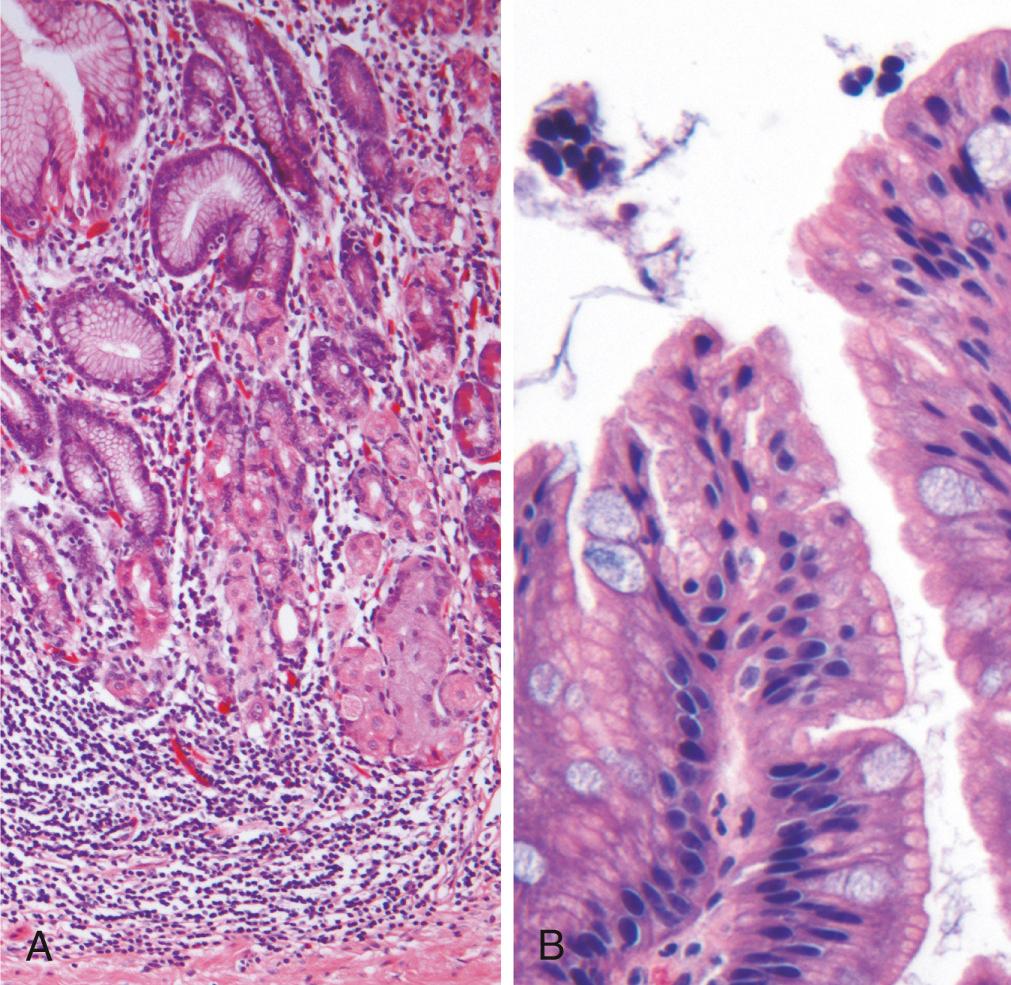
Antibodies to parietal cells and intrinsic factor are present 2 to 3 decades before the appearance of gastric atrophy and other complications such as pernicious anemia; hence, progression to clinically evident disease is slow. The median age at diagnosis is 60. Slightly more women than men are affected, and there does not appear to be an ethnic or racial bias. Pernicious anemia and autoimmune atrophic gastritis are often associated with other autoimmune diseases including Hashimoto thyroiditis, type 1 diabetes mellitus, Addison disease, and others. These associations, along with concordance in some monozygotic twins and clustering of disease in families, support a genetic predisposition. Nevertheless, there is little evidence of linkage between autoimmune gastritis and specific human leukocyte antigen (HLA) alleles.
The clinical features are mainly related to vitamin B 12 deficiency, including megaloblastic anemia ( Chapter 14 ); atrophic glossitis, in which the tongue becomes smooth and beefy red; epithelial megaloblastosis; malabsorptive diarrhea; and many others (see Chapter 28 ). Clinical features and pathologic changes related to the effects of vitamin B 12 deficiency in the marrow and the CNS (e.g., subacute combined degeneration of the spinal cord) are described in detail in Chapters 14 and 28 , respectively.
Eosinophilic gastritis is characterized by tissue damage associated with dense infiltrates of eosinophils in the mucosa and muscularis, usually in the antral or pyloric region. The lesion may also be present at other sites within the GI tract and is associated with peripheral eosinophilia and increased serum IgE levels. Allergic reactions are one cause of eosinophilic gastritis, with cow's milk and soy protein being the most common allergens in children. Eosinophilic gastritis can also occur in association with immune disorders such as systemic sclerosis and inflammatory myopathy, parasitic infections, and even H. pylori infection.
This disease preferentially affects women and produces nonspecific abdominal symptoms. It is idiopathic, but approximately 40% of cases are associated with celiac disease, suggesting an immune-mediated pathogenesis. Lymphocytic gastritis typically affects the entire stomach and is often referred to as varioliform gastritis based on the distinctive endoscopic appearance (characterized by thickened folds covered by small nodules with central aphthous ulceration). Histologically there is a marked increase in the number of intraepithelial T lymphocytes.
The descriptive term granulomatous gastritis is applied to any gastritis that contains granulomas. It encompasses a diverse group of diseases with widely varying clinical and pathologic features. Many cases are idiopathic. In Western populations, gastric involvement by Crohn disease is the most common specific cause of granulomatous gastritis followed by sarcoidosis and infections (including mycobacteria, fungi, CMV, and H. pylori ). In addition to the presence of histologically evident granulomas, narrowing and rigidity of the gastric antrum may occur secondary to transmural granulomatous inflammation.
Peptic ulcer disease (PUD) refers to chronic mucosal ulceration affecting the duodenum or stomach and is almost always associated with H. pylori infection, NSAIDs, or cigarette smoking. The most common form of PUD occurs within the gastric antrum or duodenum as a result of chronic H. pylori –induced antral gastritis, which is associated with increased gastric acid secretion and decreased duodenal bicarbonate secretion. As mentioned earlier, H. pylori infection involving the gastric fundus or body is usually accompanied by more modestly increased acid secretion due to associated gastric atrophy. Because of reduced acid secretion, individuals with gastric mucosal atrophy are generally protected from antral and duodenal ulcers. Acid secreted by ectopic gastric mucosa within the duodenum, an ileal Meckel diverticulum, or esophageal ectopic gastric mucosa (an inlet patch) may also cause PUD.
The incidence of PUD is falling along with reduced prevalence of H. pylori infection. However, PUD in patients older than 60 years has increased due to growing NSAID use. This can be amplified by H. pylori infection, which synergizes with low-dose aspirin (for cardiovascular benefits) to induce gastric injury. PUD is also associated with cigarette use and cardiovascular disease, likely due to reduced mucosal blood flow, oxygenation, and healing. Other risk factors for PUD are listed in Table 17.3 .
|
PUD results from imbalances between defense mechanisms and damaging factors that cause chronic gastritis (discussed earlier). Thus, PUD generally develops on a background of chronic gastritis. The reasons why some people develop only chronic gastritis while others develop PUD are poorly understood. However, as with H. pylori gastritis, it is likely that host factors as well as variation in pathogenicity of bacterial strains are involved.
Peptic ulcers occur in the context of chronic gastritis but are most frequently found in the proximal duodenum, within a few centimeters of the pyloric valve. Foveolar metaplasia, in which gastric-type mucus cells are present, is common in chronic duodenal peptic disease and may be a protective response, as gastric epithelia are less sensitive to acid than intestinal epithelia. Gastric peptic ulcers are predominantly located along the lesser curvature near the interface of the body and antrum.
Peptic ulcers are solitary in more than 80% of patients and form a round to oval, sharply punched-out defect ( Fig. 17.15A ). The mucosal margin is usually level with the surrounding mucosa but may overhang the base, particularly on the proximal side. In contrast, heaped-up margins are more characteristic of cancers. The depth of ulcers correlates with diameter, and deep extension may be limited by the thick gastric muscularis propria, adherent pancreas, omental fat, or the liver. Perforation into the peritoneal cavity is a surgical emergency that may be identified as free air under the diaphragm on upright abdominal radiographs.
The base of peptic ulcers is smooth and clean as a result of peptic digestion of exudate. Active ulcers may be lined by a thin layer of fibrinoid debris with a predominantly neutrophilic inflammatory infiltrate. Beneath this, granulation tissue with immature vessels, mononuclear leukocytes, and a fibrous or collagenous scar forms the ulcer base ( Fig. 17.15B ). Larger vessels within the scarred area are typically thickened and are occasionally thrombosed. Bleeding from these vessels may cause life-threatening hemorrhage. Scarring may involve the entire thickness of the wall and draw the surrounding mucosa into folds that radiate outward.
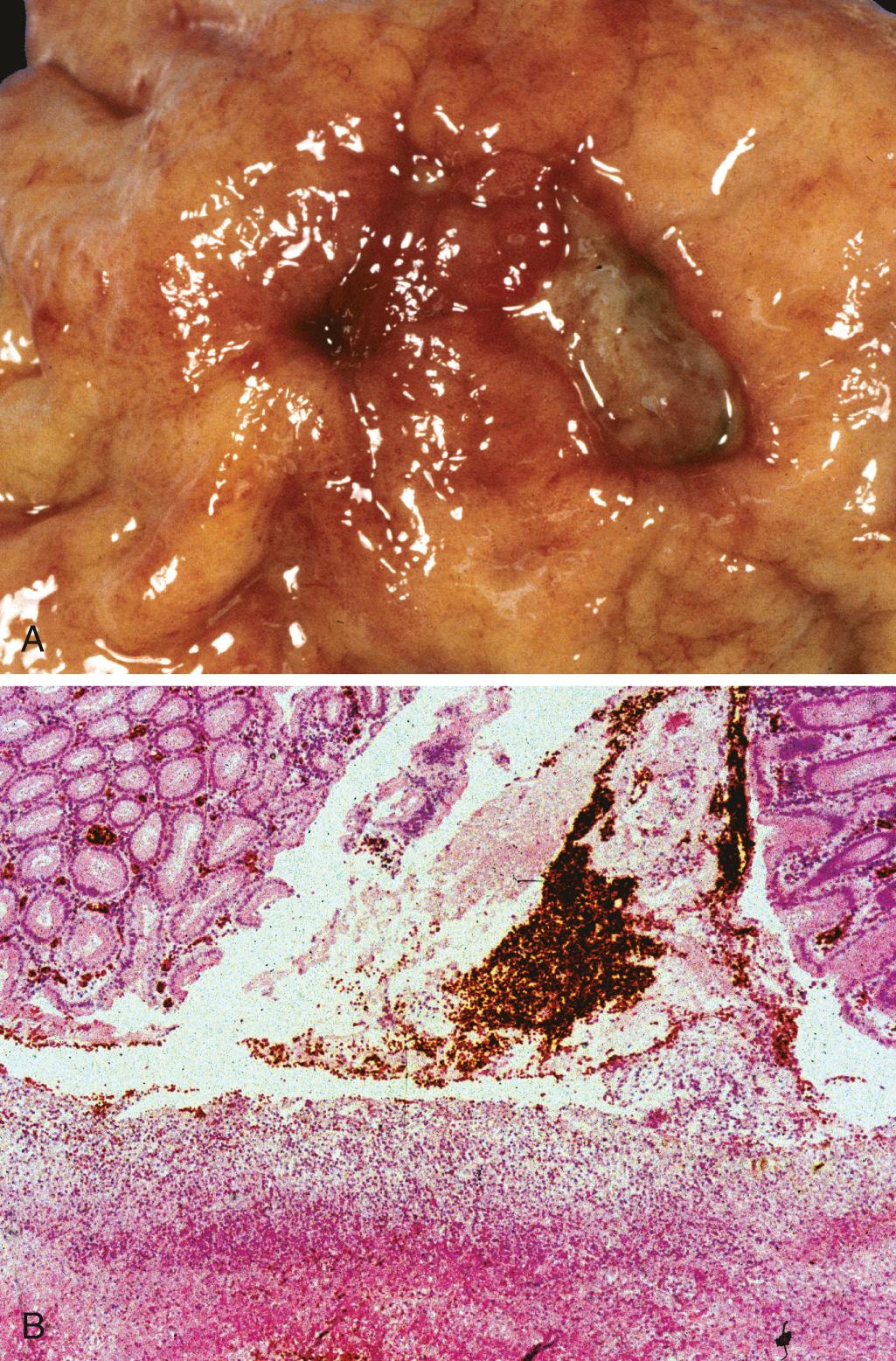
Peptic ulcers typically come to clinical attention because of epigastric burning or aching pain. Others present with iron deficiency anemia, hemorrhage, or perforation ( Table 17.4 ). The pain tends to occur 1 to 3 hours after meals during the day, is worse at night (usually between 11 p.m. and 2 a.m.), and is relieved by alkali or food. Nausea, vomiting, bloating, belching, and significant weight loss are additional manifestations. With penetrating ulcers the pain is occasionally referred to the back, left upper quadrant, or chest, where it may be misinterpreted as cardiac in origin.
| Bleeding |
| Occurs in 15%–20% of patients Most frequent complication May be life threatening Accounts for 25% of ulcer-related deaths May be the first indication of an ulcer |
| Perforation |
| Occurs in up to 5% of patients Accounts for two-thirds of ulcer-related deaths Is rarely first indication of an ulcer |
| Obstruction |
| Mostly in chronic ulcers Secondary to edema or scarring Occurs in about 2% of patients Most often associated with pyloric channel ulcers May occur with duodenal ulcers Causes incapacitating, crampy abdominal pain Can rarely cause total obstruction and intractable vomiting |
Current therapies for PUD are aimed at H. pylori eradication and neutralization of gastric acid, primarily with proton pump inhibitors. It is also important to withdraw other offending agents such as NSAIDs, including selective COX-2 inhibitors, that may interfere with mucosal healing. While peptic ulcers were previously notoriously difficult to eradicate, the recurrence rate is now less than 20% following successful clearance of H. pylori .
As noted above, chronic gastritis may lead to significant loss of parietal cell mass. This oxyntic atrophy is frequently associated with intestinal metaplasia, recognized by the presence of goblet cells, and is strongly associated with increased risk of gastric adenocarcinoma. The risk of adenocarcinoma is greatest in autoimmune metaplastic atrophic gastritis. This may be because achlorhydria of gastric mucosal atrophy permits overgrowth of bacteria that produce carcinogenic nitrosamines. Intestinal metaplasia also occurs in chronic H. pylori gastritis but may regress after clearance of the organism.
Chronic gastritis exposes the epithelium to inflammation-related free radical damage and proliferative stimuli that include regenerative responses to injury and increased production of gastrin, a gastric epithelial mitogen. Over time this combination of stressors can lead to the accumulation and amplification of genetic alterations that result in carcinoma. Preinvasive in situ lesions can be recognized histologically as dysplasia. The morphologic hallmarks of dysplasia are variations in epithelial size, shape, and orientation along with coarse chromatin texture, hyperchromasia, and nuclear enlargement. The distinction between dysplasia and regenerative epithelial changes induced by active inflammation can be a challenge for the pathologist, since increased epithelial proliferation and mitotic figures may be prominent in both. One clue is that reactive epithelial cells mature as they reach the mucosal surface, while dysplastic lesions remain cytologically immature.
Gastritis cystica is an exuberant reactive epithelial proliferation associated with entrapment of epithelial-lined cysts. These may be found within the submucosa (gastritis cystica polyposa) or deeper layers of the gastric wall (gastritis cystica profunda). Because of the association with chronic gastritis and partial gastrectomy, it is presumed that gastritis cystica is trauma-induced, but the reasons for the development of epithelial cysts within deeper portions of the gastric wall are not clear. Regenerative epithelial changes can be prominent in the entrapped epithelium, and gastritis cystica can therefore be mistaken for invasive adenocarcinoma.
Hypertrophic gastropathies are uncommon diseases characterized by giant “cerebriform” enlargement of the rugal folds due to epithelial hyperplasia without inflammation. As might be expected, the hypertrophic gastropathies are linked to excessive growth factor release. Two well-defined examples are Ménétrier disease and Zollinger-Ellison syndrome, the morphologic features of which are compared with other gastric proliferations in Table 17.5 .
| Parameter | Ménétrier Disease (Adult) | Zollinger-Ellison Syndrome | Inflammatory and Hyperplastic Polyps | Gastritis Cystica | Fundic Gland Polyps | Gastric Adenomas |
|---|---|---|---|---|---|---|
| Mean patient age, years | 30–60 | 50 | 50–60 | Variable | 50 | 50–60 |
| Location | Body and fundus | Fundus | Antrum > body | Body | Body and fundus | Antrum > body |
| Predominant cell type | Mucous | Parietal > mucous, endocrine | Mucous | Mucous, cyst-lining | Parietal and chief | Dysplastic, intestinal |
| Inflammatory infiltrate | Limited, lymphocytes | Neutrophils | Neutrophils and lymphocytes | Neutrophils and lymphocytes | None | Variable |
| Symptoms | Hypoproteinemia, weight loss, diarrhea | Peptic ulcers | Similar to chronic gastritis | Similar to chronic gastritis | None, nausea | Similar to chronic gastritis |
| Risk factors | None | Multiple endocrine neoplasia | Chronic gastritis, H. pylori | Trauma, prior surgery | PPIs, FAP | Chronic gastritis, atrophy, intestinal metaplasia |
| Association with adenocarcinoma | Yes | No | Occasional | No | Syndromic (FAP) only | Frequent |
Ménétrier disease is a rare disorder associated with excessive secretion of transforming growth factor (TGF)-α, which is an EGF receptor (EGFR) ligand, and hyperactivation of the epidermal growth factor receptor on gastric epithelial cells. Some cases occur in association with viral or H. pylori infection. Diffuse hyperplasia of foveolar epithelium within the body and fundus as well as hypoproteinemia due to albumin loss, which can approach 10 g/day, across the gastric mucosa characterize Ménétrier disease. Secondary symptoms such as weight loss, diarrhea, and peripheral edema are commonly present. Systemic effects of TGF-α, including hyperplasia of the liver, pancreas, and GI tract (beyond the stomach), muscle and adipose tissue loss, and psoriasis, may also be present. Symptoms and pathologic features of Ménétrier disease in children are similar to those in adults, but pediatric disease is usually self-limited and often follows CMV or another respiratory infection. Risk of gastric adenocarcinoma is increased in adults with Ménétrier disease.
Ménétrier disease is characterized by irregular enlargement of the gastric rugae. Some areas may appear polypoid. Enlarged rugae are present in the body and fundus ( Fig. 17.16A ), but the antrum is generally spared. Histologically, the most characteristic feature is hyperplasia of foveolar mucous cells. The glands are elongated with a corkscrew-like appearance, and cystic dilation is common ( Fig. 17.16B ). Inflammation is usually modest, although some cases show marked intraepithelial lymphocytosis. Diffuse or patchy glandular atrophy, evident as hypoplasia of parietal and chief cells, is typically intermixed with epithelial hyperplasia.
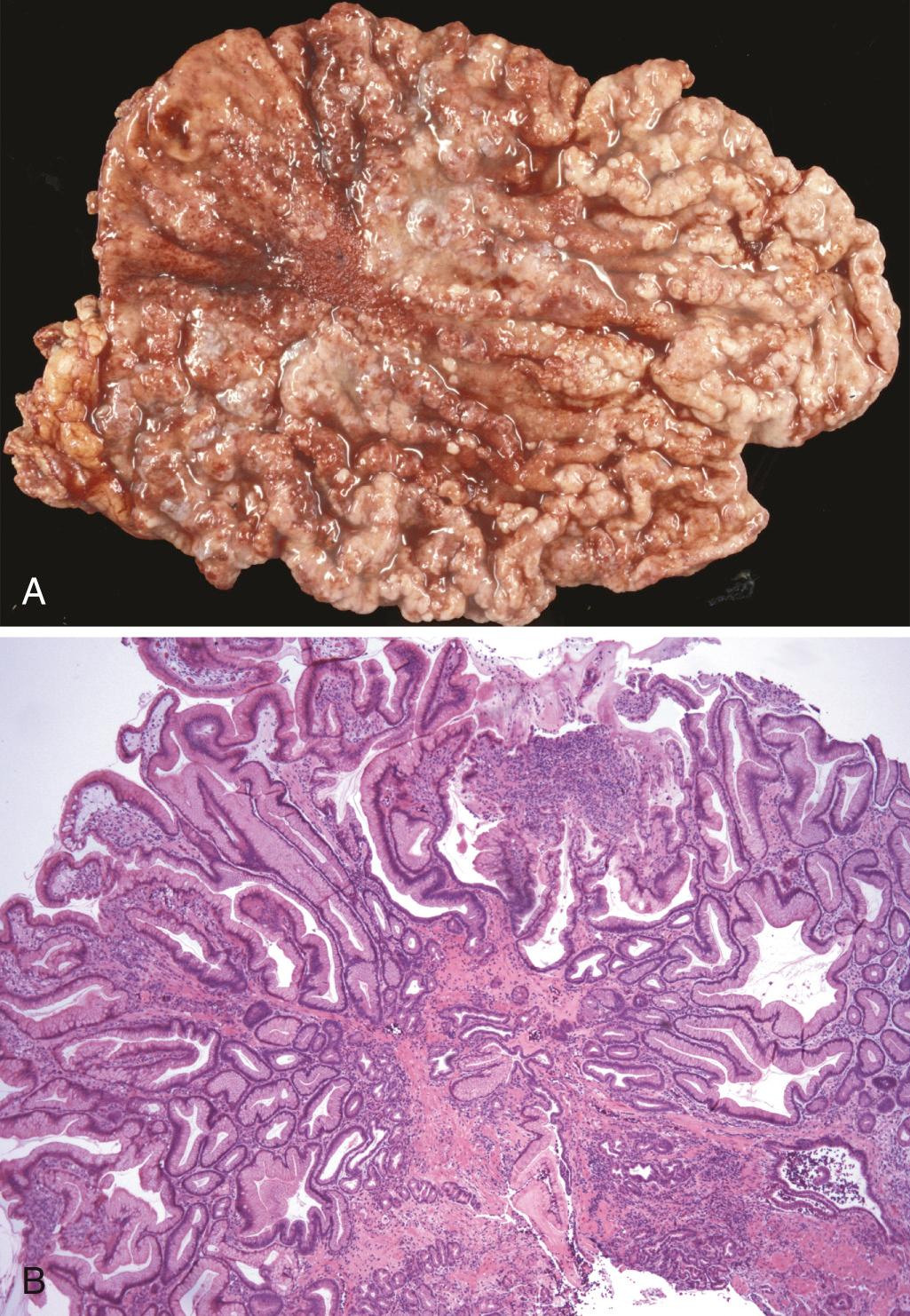
Treatment of Ménétrier disease is supportive, with intravenous albumin and parenteral nutritional supplementation. In cases associated with herpesvirus, CMV, or H. pylori, treatment of the infection may be helpful. Antibodies that block epidermal growth factor receptor activation are effective in many cases. In severe cases gastrectomy remains a therapeutic option.
Zollinger-Ellison syndrome is caused by gastrin-secreting neuroendocrine tumors. These gastrinomas are almost always found in the small intestine or pancreas. Patients often present with duodenal ulcers or chronic diarrhea. Within the stomach, the most remarkable feature is a marked increase in oxyntic mucosal thickness due to massive parietal cell hyperplasia. Gastrin also induces hyperplasia of mucous neck and endocrine cells within oxyntic mucosa.
Treatment of individuals with Zollinger-Ellison syndrome includes blockade of acid hypersecretion, typically with proton pump inhibitors. Acid suppression allows peptic ulcers to heal and prevents gastric perforation, allowing treatment to focus on the gastrinoma, which then becomes the main determinant of long-term survival.
Gastrinomas are sporadic, solitary lesions in 75% of patients. The remaining 25% of patients with gastrinomas have multiple endocrine neoplasia type 1 (MEN1). These patients are younger and primarily have duodenal tumors that commonly metastasize. MEN1 gene mutations in sporadic gastrinomas are also associated with aggressive tumor behavior. Somatostatin receptor scintigraphy or endoscopic ultrasonography can help with identification. Patients with metastatic disease may benefit from treatment with somatostatin analogues.
Gastritis is a mucosal inflammatory process. When inflammatory cells are absent or rare, the term gastropathy can be applied.
The clinical spectrum of acute gastritis ranges from asymptomatic disease to mild epigastric pain, nausea, and vomiting. Causative factors include any agent or disease that interferes with gastric mucosal protective mechanisms.
The most common cause of chronic gastritis is H. pylori infection. Other injurious agents include NSAIDs and alcohol.
H. pylori gastritis typically affects the antrum and is associated with increased gastric acid production. Later in the course of disease, the body can be involved, and resulting glandular atrophy can lead to mildly reduced acid production. Host immune responses and bacterial characteristics determine whether the infection remains antral or progresses to pangastritis and atrophy.
H. pylori gastritis induces MALT that can give rise to B-cell lymphomas (MALTomas).
After H. pylori and NSAIDs, autoimmune atrophic gastritis is the most frequent cause of chronic gastritis. It results in atrophy of the gastric body oxyntic glands, which leads to decreased gastric acid production, antral G-cell hyperplasia, and vitamin B 12 deficiency. Anti–parietal cell and anti–intrinsic factor antibodies are typically present.
Intestinal metaplasia develops in all forms of chronic gastritis and is a risk factor for gastric adenocarcinoma.
Peptic ulcer disease is usually secondary to chronic H. pylori –induced gastritis and the resulting hyperchlorhydria. Ulcers can develop in the stomach or duodenum and usually heal after suppression of gastric acid production and H. pylori eradication.
Ménétrier disease is a rare disorder caused by excessive secretion of TGF-α and characterized by diffuse foveolar hyperplasia and protein-losing enteropathy.
Zollinger-Ellison syndrome is caused by gastrin-secreting tumors that cause parietal cell hyperplasia and acid hypersecretion; 60% to 90% of these gastrinomas are malignant.
Polyps, nodules or masses that project above the level of the surrounding mucosa, are identified in up to 5% of upper GI endoscopies. Polyps may develop as a result of epithelial or stromal cell hyperplasia, inflammation, ectopia, or neoplasia. Only the most common types of gastric polyps will be discussed here (Peutz-Jeghers and juvenile polyps are discussed with intestinal polyps later).
Up to 75% of all gastric polyps are inflammatory or hyperplastic polyps. Their incidence is correlated with the regional prevalence of H. pylori infection. These polyps are most common in individuals between 50 and 60 years of age and usually develop in association with chronic gastritis, which initiates the injury that leads to reactive hyperplasia and polyp growth. The risk of dysplasia in inflammatory polyps ranges from 1% to 20% and increases sharply in pedunculated polyps greater than 1 cm in diameter.
The majority of inflammatory or hyperplastic polyps are smaller than 1 cm in diameter. Polyps are frequently multiple, particularly in individuals with atrophic gastritis. Hyperplastic polyps are ovoid in shape and have a smooth surface; superficial erosions are common in inflammatory polyps. Microscopically, polyps have irregular, cystically dilated, and elongated foveolar glands ( Fig. 17.17A ). The lamina propria is typically edematous with variable degrees of acute and chronic inflammation ( Fig. 17.17B ).
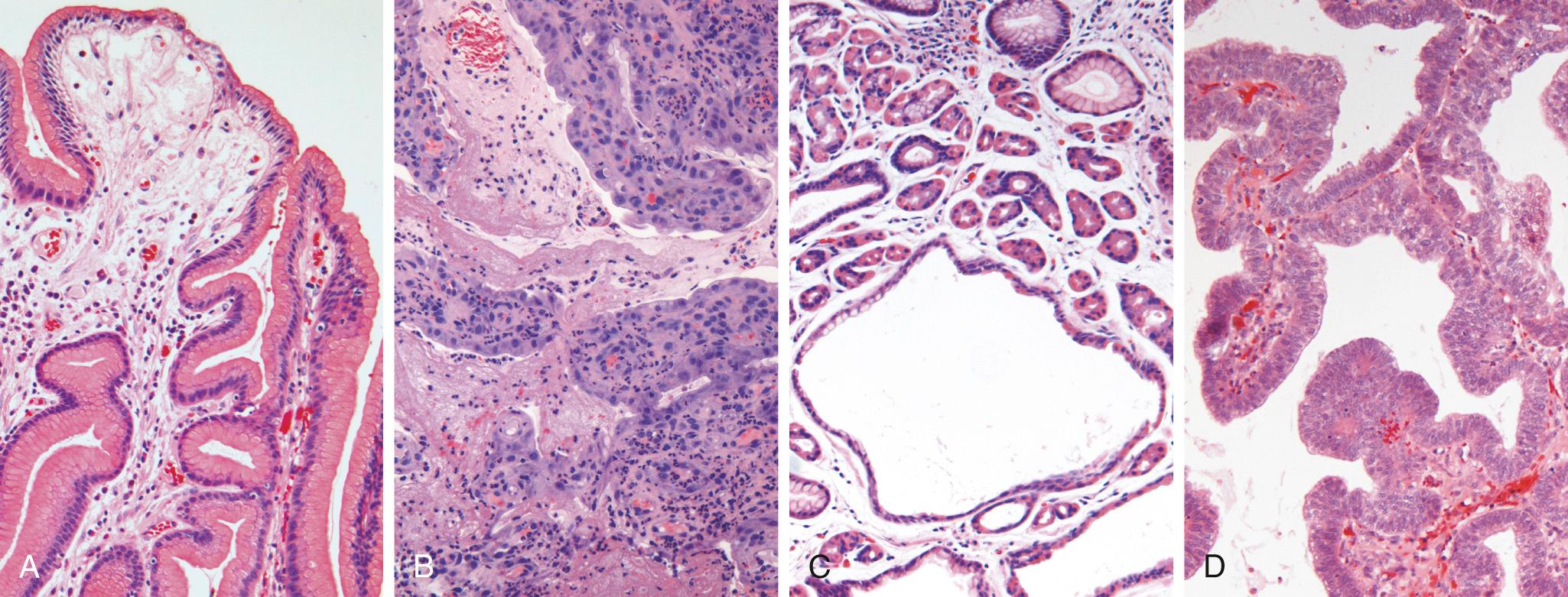
Fundic gland polyps occur sporadically and in individuals with germline mutations in the APC gene (the cause of familial adenomatous polyposis) or the DNA repair gene MUTYH (both discussed later). The prevalence of sporadic fundic gland polyps has increased markedly in recent years as a result of increased use of proton pump inhibitors. These drugs inhibit acid production, which leads to increased gastrin secretion and, in turn, oxyntic gland growth. Fundic gland polyps may be asymptomatic or associated with nausea, vomiting, or epigastric pain.
Fundic gland polyps occur in the gastric body and fundus and are well-circumscribed lesions with a smooth surface. They may be single or multiple and are composed of cystically dilated, irregular glands lined by parietal, chief, and foveolar mucus cells. Inflammation is typically absent or minimal ( Fig. 17.17C ). Dysplasia may occur in FAP-associated fundic gland polyps, and rare cancers have been reported. In contrast, sporadic fundic gland polyps, including those arising in association with proton pump inhibitor therapy, do not carry a significant risk of neoplasia.
Most gastric adenomas develop in a background of chronic gastritis with atrophy and intestinal metaplasia, with the exception of those associated with germline mutations in APC or MUTYH . They represent up to 10% of all gastric polyps (see Table 17.5 ). Their frequency increases progressively with age, and there is a marked variation in prevalence among different populations that parallels the incidence of gastric adenocarcinoma. Patients are usually between 50 and 60 years of age, and males are affected three times more often than females. The risk of adenocarcinoma within gastric adenomas correlates with size and is particularly elevated in lesions greater than 2 cm in diameter. Gastric adenomas have a greater risk of cancer (up to 30% when large) and must be managed more aggressively than colonic adenomas.
Gastric adenomas are usually solitary antral lesions. All GI adenomas exhibit dysplasia, which is classified as low- or high-grade ( Fig. 17.17D ). Both grades of dysplasia are characterized by nuclear enlargement, elongation, pseudostratification, and hyperchromasia. High-grade dysplasia is marked by more severe cytologic atypia and architectural abnormalities, including glandular budding and gland-within-gland, or cribriform, structures.
Become a Clinical Tree membership for Full access and enjoy Unlimited articles
If you are a member. Log in here